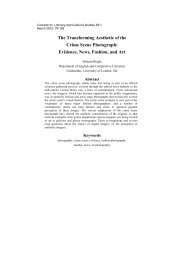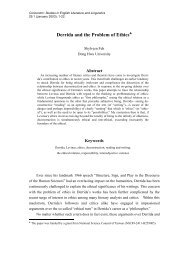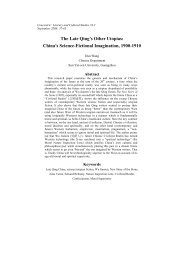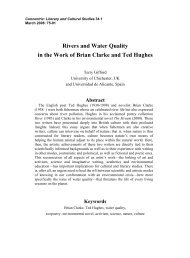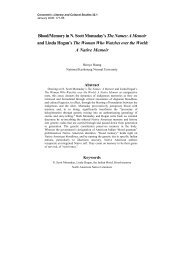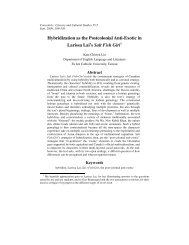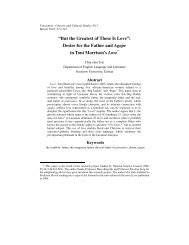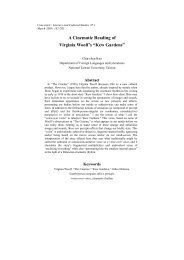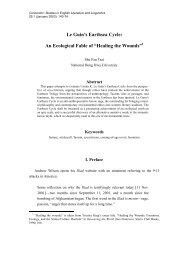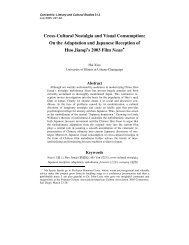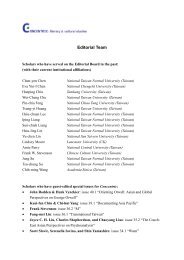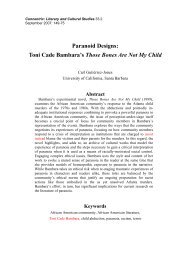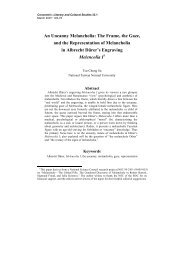Reading Yaşar Kemal's The Sea-Crossed Fisherman in ... - Concentric
Reading Yaşar Kemal's The Sea-Crossed Fisherman in ... - Concentric
Reading Yaşar Kemal's The Sea-Crossed Fisherman in ... - Concentric
You also want an ePaper? Increase the reach of your titles
YUMPU automatically turns print PDFs into web optimized ePapers that Google loves.
<strong>Concentric</strong>: Literary and Cultural Studies 34.1March 2008: 45-74<strong>Read<strong>in</strong>g</strong> <strong>Yaşar</strong> Kemal’s <strong>The</strong> <strong>Sea</strong>-<strong>Crossed</strong> <strong>Fisherman</strong><strong>in</strong> the Year of the Dolph<strong>in</strong>Ufuk ÖzdağHacettepe University, TurkeyAbstractEnvironmental literature has a crucial function to play <strong>in</strong> rais<strong>in</strong>genvironmental awareness, for such literature <strong>in</strong>culcates ecocentric values topublic consciousness through heartfelt narratives of lived tragedies <strong>in</strong>“particular places” across the globe. One f<strong>in</strong>e example belongs to Turkey’smost <strong>in</strong>fluential liv<strong>in</strong>g author, <strong>Yaşar</strong> Kemal; his novel <strong>The</strong> <strong>Sea</strong>-<strong>Crossed</strong><strong>Fisherman</strong> (1978), with its sett<strong>in</strong>g of Istanbul and its environs, takes up theissue of large-scale dolph<strong>in</strong> hunts <strong>in</strong> Turkish coastal waters <strong>in</strong> the early 1950s,a tragedy that was banned <strong>in</strong> 1983 but is still cont<strong>in</strong>u<strong>in</strong>g <strong>in</strong> many coastalwaters around the world. <strong>The</strong> novel, <strong>in</strong> rich language <strong>in</strong>spired by the epicstyles of the Anatolian oral tradition and Turkish folklore and legends, makesa forceful call for extend<strong>in</strong>g moral concern to the environment. <strong>The</strong> novel’secocentric approach covers the rights of both the Marmara ecosystemdevastated follow<strong>in</strong>g the overexploitation of dolph<strong>in</strong>s for their oil and the<strong>in</strong>tr<strong>in</strong>sically valuable dolph<strong>in</strong>s, with their capacity for cognition and humanlikeemotions. Still, the greatness of the novel lies <strong>in</strong> Kemal’s conviction thatchanges <strong>in</strong> the natural world are followed by changes <strong>in</strong> human nature—this isperhaps Kemal’s unique contribution to environmental studies. Along with thedevastation that befalls Istanbul and its environs, the novel presents picturesfrom the lives of alienated, unwholesome human characters who confer onlyeconomic value to nature and its species. In the Year of the Dolph<strong>in</strong> (2007—extended <strong>in</strong>to 2008), part of the UN Decade on Education for Susta<strong>in</strong>ableDevelopment (which aims, among other th<strong>in</strong>gs, to make peoples of the worldaware of the threats fac<strong>in</strong>g dolph<strong>in</strong>s and to stop the exploitation of the seas ofthe world), it is crucial to read Kemal’s <strong>The</strong> <strong>Sea</strong>-<strong>Crossed</strong> <strong>Fisherman</strong>, for it isboth a plea and a strong voice to br<strong>in</strong>g about transformation <strong>in</strong> our valuesystems that will lead to <strong>in</strong>creased protection of the environment, <strong>in</strong>clud<strong>in</strong>gthe world’s oceans.Keywords<strong>Yaşar</strong> Kemal, <strong>The</strong> <strong>Sea</strong>-<strong>Crossed</strong> <strong>Fisherman</strong>, Year of the Dolph<strong>in</strong>,environmental literature, dolph<strong>in</strong> hunts, <strong>in</strong>tr<strong>in</strong>sic values, sea literature
46<strong>Concentric</strong> 34.1March 2008“Astraddle on the dolph<strong>in</strong>’s mire and blood,Spirit after spirit!”—W. B. Yeats, “Byzantium” 248“<strong>The</strong>y have sta<strong>in</strong>ed the Marmara with the bloodof the dolph<strong>in</strong>s. <strong>The</strong> Marmara was filled withthe cry of the dolph<strong>in</strong>s, with death, with blacksmoke.”—<strong>Yaşar</strong> Kemal, Denizler Kurudu 163<strong>The</strong> United Nations Convention on Migratory Species declared 2007 the Yearof the Dolph<strong>in</strong> (and this “year” has been extended <strong>in</strong>to 2008). <strong>The</strong> Year of theDolph<strong>in</strong> is part of the UN Decade on Education for Susta<strong>in</strong>able Development. Thisremarkable campaign, <strong>in</strong>volv<strong>in</strong>g Governments, NGOs, and the private sector ofcountries around the world, aims to raise global awareness of the threats fac<strong>in</strong>gdolph<strong>in</strong>s and promote their conservation <strong>in</strong> the world’s oceans. <strong>The</strong> officialcampaign website states that “crucial elements <strong>in</strong> achiev<strong>in</strong>g this are educat<strong>in</strong>g tocreate awareness of dolph<strong>in</strong> species and their situation, alert<strong>in</strong>g and <strong>in</strong>form<strong>in</strong>gdecision makers and <strong>in</strong>volv<strong>in</strong>g local communities <strong>in</strong> grassroots action.” 1 <strong>The</strong> newlyfounded <strong>in</strong>stitutes, soar<strong>in</strong>g dolph<strong>in</strong> research publications and the media are allcontribut<strong>in</strong>g to the creation of “an ocean home [for dolph<strong>in</strong>s] that is safe fromharm.” 2It seems that now, <strong>in</strong> the West, more and more people are aware of the<strong>in</strong>tr<strong>in</strong>sic value of dolph<strong>in</strong>s. But the questions now are: how effectively will this<strong>in</strong>formation get dissem<strong>in</strong>ated to the public <strong>in</strong> the rest of the world, how willdecision makers around the world be <strong>in</strong>formed, and how will local communities be<strong>in</strong>volved when many attempts at creat<strong>in</strong>g a greater awareness of dolph<strong>in</strong>endangerment still rely on “abstract <strong>in</strong>formation”—<strong>in</strong>formation based on theirexploitation <strong>in</strong> seas everywhere and not on “experiential discourse.” 3 Throughrecent reports, we are made aware that tens of thousands of dolph<strong>in</strong>s have beenslaughtered <strong>in</strong> dolph<strong>in</strong> harvests by coastal communities around the world. Yetevidently, such numerical <strong>in</strong>formation concern<strong>in</strong>g the massive exploitation of1 See the website: .2 Ibid.3 I borrow these terms from Scott Slovic and Paul Slovic, “Numbers and Nerves: Toward anEffective Apprehension of Environmental Risk” (14).
Özdağ<strong>Read<strong>in</strong>g</strong> <strong>Yaşar</strong> Kemal’s <strong>The</strong> <strong>Sea</strong>-<strong>Crossed</strong> <strong>Fisherman</strong>47doph<strong>in</strong>s has not led to a substantial change <strong>in</strong> global ethics, one that would promptaction aga<strong>in</strong>st the perpetrators of wanton cruelty.What is needed seems to be an <strong>in</strong>timate story told <strong>in</strong> a “particular place” <strong>in</strong> theworld, a story that touches the souls of readers rather than a discourse that reducesthe value of natural phenomena to mathematical (and often economic) calculations. 4“Environmental risks—both the risks we expose ourselves to when we live <strong>in</strong>the world and the risks of human impacts on the natural world—are often described<strong>in</strong> language poorly suited to overcome the numb<strong>in</strong>g, desensitiz<strong>in</strong>g effects of abstract,quantitative discourse” (14), say Scott Slovic and Paul Slovic <strong>in</strong> “Numbers andNerves: Toward an Effective Apprehension of Environmental Risk.” <strong>The</strong>y rightlypo<strong>in</strong>t to the power of environmental literature to provide us with <strong>in</strong>timate storiesand images that can cut through the m<strong>in</strong>d-numb<strong>in</strong>g effect of mere statistics. Here<strong>in</strong>lies the key to reach<strong>in</strong>g people’s hearts and <strong>in</strong>culcat<strong>in</strong>g ecocentric values <strong>in</strong> thepublic consciousness. Such literature exposes man’s cruelty to nature and its species<strong>in</strong> diverse corners of the world, <strong>in</strong> a language that touches even the hearts of peoplewho are <strong>in</strong>different to nature or unaware of it. At this worrisome stage of humancivilization that we have entered <strong>in</strong>to unth<strong>in</strong>k<strong>in</strong>gly at the open<strong>in</strong>g of the 21stcentury, we need to consider seriously this crucial function of literature and listen tostories that strengthen our bonds with nonhuman species.One such story has been written on the overexploitation of dolph<strong>in</strong>s byTurkey’s “Homer,” 5 <strong>Yaşar</strong> Kemal (born <strong>in</strong> 1922). This world-famous writer isrightly known as an advocate of human rights who has stood up for the exploited <strong>in</strong>the bulk of his work. In his highly acclaimed novel <strong>The</strong> <strong>Sea</strong>-<strong>Crossed</strong> <strong>Fisherman</strong>(1978), Kemal stands up for nature’s rights and turns “quantitative discourse” <strong>in</strong>tomean<strong>in</strong>gful images <strong>in</strong> order to call for a new human consciousness that would bemore holistically oriented. Kemal did not write his novel out of the same4 For a discussion on the significance of “experiential narratives of specific places” <strong>in</strong>environmental literature, see Slovic 17-23.5 See Talat Sait Halman, “Open<strong>in</strong>g Speech,” Geçmişten Geleceğe <strong>Yaşar</strong> Kemal: BilkentÜniversitesi Türk Edebiyatı Merkezi Uluslararası <strong>Yaşar</strong> Kemal Sempozyumu. Halman, <strong>in</strong> thevaledictory speech at the symposium honor<strong>in</strong>g <strong>Yaşar</strong> Kemal, repeats the words of OlofLagercrantz’s who named Kemal as “Turkey’s Homer” (20). Also see, Yasar Kemal on His Lifeand Art, where Kemal himself refers to Azra Erhat, the Turkish Translator of the Iliad andOdyssey, who was “so moved by [Kemal’s] joy [at Mount Ida] that afterward she published anarticle titled ‘Homerosoğlu <strong>Yaşar</strong> Kemal’—‘<strong>Yaşar</strong> Kemal, son of Homer’” (82).
48<strong>Concentric</strong> 34.1March 2008“dolph<strong>in</strong>-<strong>in</strong>spiration” 6 that led to the writ<strong>in</strong>g of the Legend of the Golden Dolph<strong>in</strong>.Kemal’s fiction, <strong>in</strong>stead, is based on a real tragedy that took place <strong>in</strong> Turkishcoastal waters <strong>in</strong> the early 1950s. Through his magical and lyrical narrative thatseeks to reach people from all cultures and all walks of life, Kemal sparks renewed<strong>in</strong>terest <strong>in</strong> dolph<strong>in</strong>-human contact <strong>in</strong> contemporary times, long after the legends andmyths of dolph<strong>in</strong>-human contact have faded <strong>in</strong>to the immemorial past.“Many early cultures have dolph<strong>in</strong> tales, but around one thousand years agothe stories dry up,” states Scott Taylor <strong>in</strong> his Souls <strong>in</strong> the <strong>Sea</strong>; he proceeds to saythat “[<strong>in</strong>] recent times this Spirit has resurfaced, com<strong>in</strong>g once aga<strong>in</strong> to offer us<strong>in</strong>spiration” (9). Kemal’s novel, published thirty years ago, has a specialsignificance: dolph<strong>in</strong> hunt<strong>in</strong>g was still practiced <strong>in</strong> Turkish coastal waters whenKemal wrote <strong>The</strong> <strong>Sea</strong>-<strong>Crossed</strong> <strong>Fisherman</strong>, and the novel can be considered a pleafor end<strong>in</strong>g the exploitation of these creatures. As the ma<strong>in</strong> character, Fisher Selim,says, “[t]he dolph<strong>in</strong> is like a human be<strong>in</strong>g, it is human. To kill it is worse thankill<strong>in</strong>g a man. Why, it is even holy—it protected our Prophet Jonah and kept him <strong>in</strong>its belly for forty days and forty nights” (36). 7 What follows,then, is my contentionthat it is effective stories such as Kemal’s novel, reverberat<strong>in</strong>g with <strong>in</strong>tense humanefeel<strong>in</strong>gs, which make us remember our ancient (primal) bonds with these mosthumanlike be<strong>in</strong>gs of the seas.6 Scott Taylor reveals[t]he idea that there has been a wave of Dolph<strong>in</strong>-<strong>in</strong>spiration wash<strong>in</strong>g its wayaround the world comes from a study done by a man <strong>in</strong> Australia. PeterShenstone experienced a flood of <strong>in</strong>sights one night <strong>in</strong> 1976 while sitt<strong>in</strong>g <strong>in</strong>meditation <strong>in</strong> his home <strong>in</strong> Sydney. . . . An <strong>in</strong>ner voice told him how humanity hasbenefited from the guidance of dolph<strong>in</strong>s, outl<strong>in</strong><strong>in</strong>g a scenario that leads <strong>in</strong>to anexcit<strong>in</strong>g future of health, harmony, passion, and creativity. Peter made a twelveyearstudy of this idea and created a set of hand-written and illustrated bookscalled <strong>The</strong> Legend of the Golden Dolph<strong>in</strong>. (297)7 In the Qur’an, specifically <strong>in</strong> Sura 21 and Sura 37, Prophet Jonah was swallowed by a “bigfish.” However, <strong>in</strong> Turkish oral narratives, the “big fish” is transformed <strong>in</strong>to the “dolph<strong>in</strong>.” <strong>The</strong>transformation <strong>in</strong>to the “dolph<strong>in</strong>” is probably due to the semi-closed seas where the largest fishare the dolph<strong>in</strong>s, not the whales. Another reason for the transformation can be attributed to thehumanlike characteristics of dolph<strong>in</strong>s.
Özdağ<strong>Read<strong>in</strong>g</strong> <strong>Yaşar</strong> Kemal’s <strong>The</strong> <strong>Sea</strong>-<strong>Crossed</strong> <strong>Fisherman</strong>49In the moral geography of his narrative, 8 which closely corresponds to theAmerican ecologist Aldo Leopold’s call for a “land ethic,” Kemal <strong>in</strong>cludes thewaters of our planet and the earth’s nonhuman species with<strong>in</strong> the “boundaries” ofethical consideration. 9 He warned us of the dangers of ecological devastationthrough past and present large-scale dolph<strong>in</strong> hunts, at a time when nature’s rightswere be<strong>in</strong>g defended by neither local communities nor government officials. In theabsence of respect for mar<strong>in</strong>e life on the part of fish<strong>in</strong>g communities, Kemal’snarrative illum<strong>in</strong>ates dolph<strong>in</strong>s’ <strong>in</strong>telligence and emotional life. <strong>The</strong> author narrateshis story with a strong emphasis on the liv<strong>in</strong>g memories of fishermen. Written <strong>in</strong> arich language <strong>in</strong>spired by the epic styles of Anatolian oral tradition, Turkishfolklore and legends, and world mythologies, 10 the novel makes a deep impact onthe reader. This impact arises not so much from the mere “numbers” of dolph<strong>in</strong>shunted as from the protagonist, Fisher Selim, whose bond<strong>in</strong>g with a Marmaradolph<strong>in</strong> makes us realize the immensity of the suffer<strong>in</strong>g endured by creatures <strong>in</strong>Turkish coastal waters <strong>in</strong> the 1950s and thereafter:Nobody had ever loved Fisher Selim like this huge three-metre-longdolph<strong>in</strong>, not his mother, nor his father, not the comrades by whoseside he had fought <strong>in</strong> the war, not his brothers, not the8 In the many-layered narrative of <strong>The</strong> <strong>Sea</strong>-<strong>Crossed</strong> <strong>Fisherman</strong>, dolph<strong>in</strong> hunt<strong>in</strong>g <strong>in</strong> the <strong>Sea</strong> ofMarmara (the paper’s focus) is accompanied by side stories (e.g., Zeynel’s story) that may beperceived as digressions from the ma<strong>in</strong> story; however, these side stories weave new dimensionsand complexity to the ma<strong>in</strong> narrative and also demonstrate Kemal’s power as an epic narrator. InTurkish oral narratives, the ma<strong>in</strong> story is usually supported by side stories that are essential tonarrative tension.9 Aldo Leopold, the foundational figure <strong>in</strong> modern ecocentric ethics, famously stated: “[t]he landethic simply enlarges the boundaries of community to <strong>in</strong>clude soils, waters, plants, and animals,or collectively: the land” (239). Some of Kemal’s essays (<strong>in</strong> the collected works <strong>Yaşar</strong> Kemal:Zulmün Artsın and <strong>Yaşar</strong> Kemal: Ağacın Çürüğü) on the need to extend moral concern to the landcorrespond to Leopold’s call for a “land ethic.” See Kemal “Doğayı Öldürmek,” (Destroy<strong>in</strong>gNature) 35-38, and Kemal “Öldürülen Toprak” (Land That Is Be<strong>in</strong>g Destroyed) 43-47 <strong>in</strong> <strong>Yaşar</strong>Kemal: Zulmün Artsın. Also see Kemal “Doğanın Öldürülmesi,” (<strong>The</strong> Destruction of Nature)107-10, <strong>in</strong> <strong>Yaşar</strong> Kemal: Ağacın Çürüğü.10 <strong>Yaşar</strong> Kemal’s style is rich with narratives from both Turkish and other cultures. Kemalexpla<strong>in</strong>s this quality of his work as be<strong>in</strong>g a derivative of the Anatolian culture itself. As he reveals<strong>in</strong> A’dan Z’ye <strong>Yaşar</strong> Kemal (<strong>Yaşar</strong> Kemal from A to Z), edited by Alpay Kabacalı, “once youtravel <strong>in</strong> Anatolia, you will come across fragments from Homer <strong>in</strong> our tales. . . . In our folk storiesone comes across H<strong>in</strong>du tales as well. One can collect Arabian tales, stories from A Thousand andOne Nights <strong>in</strong> Anatolia today. One can even observe fragments from the epic of Gilgamish <strong>in</strong>Anatolia’s tales today. <strong>The</strong>se legends and tales exist <strong>in</strong> our oral tradition, and are told <strong>in</strong> amagnificient language. . . . I am a product of Anatolia. As I created my language, I created myselfwith Anatolia” (17; translated by the author).
50<strong>Concentric</strong> 34.1March 2008fellow-fishermen whose lives he had saved, only one other person,just one. . . . Just let the dolph<strong>in</strong> not see Fisher Selim’s boat for a fewdays. . . . He would go mad, turn<strong>in</strong>g the vast Marmara <strong>Sea</strong> <strong>in</strong>side out,dash<strong>in</strong>g at lightn<strong>in</strong>g speed from Yalova to the Bosphorus, from theBosphorus to the Gulf of Saros, with all his family at his tail, frantic,griev<strong>in</strong>g. He would approach every boat <strong>in</strong> sight, enquir<strong>in</strong>g for hisfriend Fisher Selim, search<strong>in</strong>g among the craft along the shore,tirelessly, ceaselessly. And the fishermen would come to Selim andsay: “He was beat<strong>in</strong>g about the sea aga<strong>in</strong> today, your pet, hey, FisherSelim, look<strong>in</strong>g for you!” And Fisher Selim, his heart swell<strong>in</strong>g withlove and pride, would th<strong>in</strong>k that there was some beauty, some hopeleft <strong>in</strong> be<strong>in</strong>g human. (SCF 11 27)<strong>Yaşar</strong> Kemal’s works are characterized by his lov<strong>in</strong>g concern for the naturalenvironment and its species. 12 As a matter of fact, Kemal has been called “one ofthe pioneers of world literature” 13 <strong>in</strong> his tireless pursuit of greater environmentalawareness. His <strong>in</strong>spiration as an environmental writer comes from his childhood,which was rooted <strong>in</strong> the landscape: he was raised <strong>in</strong> the Çukurova region 14 ofTurkey, where he had a firsthand experience of nature. Kemal’s decision to becomea writer came later <strong>in</strong> his life, but his lifelong love of nature—ga<strong>in</strong>ed <strong>in</strong>childhood—seeps <strong>in</strong>to each and every one of his works. He has described the“emotional landscape” of his childhood as a free one with “no closed doors.” Hestates:11 <strong>The</strong> <strong>Sea</strong>-<strong>Crossed</strong> <strong>Fisherman</strong> is hereafter abbreviated as SCF <strong>in</strong> the parentheticaldocumentation.12 For Kemal’s approach to nature, see Kemal, “Nature as the Foundation of Literature andLife,” <strong>Yaşar</strong> Kemal on His Life and Art 81-83; also see Andaç, “Transformation of Man andNature,” Liv<strong>in</strong>g Through the Words of <strong>Yaşar</strong> Kemal 141-57. For nature’s crucial role <strong>in</strong> some ofKemal’s novels (<strong>in</strong>clud<strong>in</strong>g <strong>The</strong> <strong>Sea</strong>-<strong>Crossed</strong> <strong>Fisherman</strong>), see Clare Brandabur’s unpublishedessay, “Life, Death, and Memory: Ecological Dimensions <strong>in</strong> the Work of <strong>Yaşar</strong> Kemal,” whereBrandabur states, “[Kemal] can be considered the most profoundly eco-conscious writer of ourtime” (2).13 Oğuzertem reveals, “[a]lthough <strong>Yaşar</strong> Kemal’s concern for nature is widely known, very feware aware that he is actually one of the pioneers of world literature <strong>in</strong> this regard. Environmentalconcerns come to the fore seriously start<strong>in</strong>g from the 1970’s <strong>in</strong> the world. . . . Concern for nature<strong>in</strong> Turkish literature was seriously undertaken by writers such as <strong>Fisherman</strong> of Halicarnassus andSait Faik [Abasıyanık], and later by <strong>Yaşar</strong> Kemal who followed their lead. With their literaryoutput, Turkish literature is, <strong>in</strong> fact, avantguardist <strong>in</strong> the world” (38; translated by the author).14 Çukurova is the ancient region of Cilicia <strong>in</strong> southern Anatolia. <strong>Yaşar</strong> Kemal, aim<strong>in</strong>g to reachthe global through the local, views Çukurova as his Yoknapatawpha County.
Özdağ<strong>Read<strong>in</strong>g</strong> <strong>Yaşar</strong> Kemal’s <strong>The</strong> <strong>Sea</strong>-<strong>Crossed</strong> <strong>Fisherman</strong>51One day I chose to stay among the eagles’ nests <strong>in</strong> the mounta<strong>in</strong>s;another day I was <strong>in</strong> the pla<strong>in</strong> on the ramparts of the castle with thesnakes; on still another day I was <strong>in</strong> the pomegranate groves, or bythe fig trees <strong>in</strong> the village. . . . One day I could be found on the banksof the Savrun River, on a spree among the purple sweet marjoram;another day I was under the tents of Yörük nomads, with a falcon, ahawk, or a sparrow hawk on my wrist, a gift of the Yörüks. Onanother day I sat as a disciple <strong>in</strong> the presence of a bard, while on thefollow<strong>in</strong>g day, I roamed around the countryside with treasure hunters.It was a vast world. (YKLA 15 25-26)<strong>The</strong> <strong>Sea</strong>-<strong>Crossed</strong> <strong>Fisherman</strong>, set <strong>in</strong> Istanbul and its environs, is one ofKemal’s sea novels. With its deep yearn<strong>in</strong>g for the once healthy ecosystem <strong>in</strong> thisparticular part of the world, the novel presents pictures of devastation <strong>in</strong> both theland and the water. 16 In Kemal’s own words, the novel “is the story of alienation ofall big cities <strong>in</strong> the whole world <strong>in</strong> agony because of the environmental, humancrisis” (Andaç 63). 17 <strong>The</strong> author claims that Istanbul is “on its death-bed” and goeson to say, “[o]ur city has been put <strong>in</strong>to this state by a savage creature called Man.<strong>The</strong>se creatures do not appreciate the city they live <strong>in</strong>, don’t appreciate the water,the sea, human be<strong>in</strong>gs or even themselves” (Andaç 145). Kemal’s “savages” are theecologically illiterate fishermen and especially the real estate speculator Halim BeyVeziroğlu and his associates, those responsible for the commodification of thewaters of the Marmara and of the land.<strong>The</strong> novel starts out by emphasiz<strong>in</strong>g the human impact on the <strong>Sea</strong> of Marmaraand ends with a glimmer of hope that nature will heal itself. In the <strong>in</strong>terven<strong>in</strong>gpages, twenty-five chapters altogether, Kemal gives us scenes from the lives of thealienated fishermen liv<strong>in</strong>g <strong>in</strong> Menekşe (a coastal town on the Marmara <strong>Sea</strong> near15 <strong>Yaşar</strong> Kemal on His Life and Art is hereafter abbreviated as YKLA <strong>in</strong> the parentheticaldocumentation.16 In Kemal’s, Al Gözüm Seyreyle Salih (1976), another sea novel set <strong>in</strong> Şile on the Black <strong>Sea</strong>coast, there is a reference to the overexploitation of dolph<strong>in</strong>s for their oil <strong>in</strong> the Black <strong>Sea</strong>. As thenarrater reveals, “[t]hese seas teemed with dolph<strong>in</strong>s <strong>in</strong> the past times. . . . Nowadays there are notany dolph<strong>in</strong>s, not even one s<strong>in</strong>gle left” (192; translated by the author).17 <strong>Yaşar</strong> Kemal says, “[i]f I write <strong>The</strong> <strong>Sea</strong>-<strong>Crossed</strong> <strong>Fisherman</strong> and picture an Istanbul on itsdeath-bed, if I describe the collapse of people, of nature and of the sea, if I tell about the agony ofdeath, about alienation, I am describ<strong>in</strong>g today, the present-day world, thus I am contemporary.And this is not just reality <strong>in</strong> Turkey. <strong>The</strong> <strong>Sea</strong>-<strong>Crossed</strong> <strong>Fisherman</strong> was published <strong>in</strong> France, <strong>in</strong>England and <strong>in</strong> the US. It does not reflect th<strong>in</strong>gs for the city of Istanbul only; the same holds truefor Rome, for Paris and for Stockholm” (Andaç 63).
52<strong>Concentric</strong> 34.1March 2008Istanbul, jeopardized by the encroachment of urbanization), and from the lives ofthe despondent poor people who are runn<strong>in</strong>g after property and wealth at the cost ofthe environment. He also gives us a series of crimes committed by the outlaws, thedestruction of the once idyllic landscape, and Fisher Selim’s life story as revealed tothe anonymous narrator dur<strong>in</strong>g their fish<strong>in</strong>g trips. With<strong>in</strong> the vast scope of thisnovel, a manhunt across historic İstanbul—the police are chas<strong>in</strong>g Zeynel, amurderer—and a dolph<strong>in</strong> hunt that stretches across the <strong>Sea</strong> of Marmara are<strong>in</strong>tervowen, mak<strong>in</strong>g clear the immensity of the destruction that has befallen naturedue to the materialism and greed of people who, hav<strong>in</strong>g become alienated evenfrom themselves, have been stripped bare of their humanity.Dolph<strong>in</strong> Hunts <strong>in</strong> <strong>The</strong> <strong>Sea</strong>-<strong>Crossed</strong> <strong>Fisherman</strong>In the novel’s sprawl<strong>in</strong>g narrative Kemal takes up the issue of commercialdolph<strong>in</strong> hunt<strong>in</strong>g <strong>in</strong> the Marmara <strong>in</strong> the early 1950s, a historical event practiced“along the entire Turkish Black <strong>Sea</strong> coast from İğneada to Rize” (Öztürk 1998)until 1983, and may have caused irreversible losses <strong>in</strong> and to the waters of theMarmara. 18 <strong>Read<strong>in</strong>g</strong> the author’s brutal descriptions of the hunts, one cannot helpwonder<strong>in</strong>g whether he was writ<strong>in</strong>g from first-hand experience. When I asked Kemalabout this he told me it was so, say<strong>in</strong>g he had witnessed the violent dolph<strong>in</strong> hunts ofthe early 1950s. He also said that he had had to wait for more than twenty years toturn it <strong>in</strong>to a novel because the “tragedy” he had witnessed was more than he couldendure. “Some can write about cruelty, but not me,” he said. “I had to wait until1977 when I went to live <strong>in</strong> Sweden; there I decided to take up the issue.” 19 Kemal18 <strong>The</strong> exist<strong>in</strong>g scientific data on these years covers the decimation of dolph<strong>in</strong>s, not <strong>in</strong> theMarmara, but <strong>in</strong> the coastal waters of the Black <strong>Sea</strong>. See statistics of dolph<strong>in</strong> catches for formerSoviet Union, Bulgaria, and Turkey <strong>in</strong> the Black <strong>Sea</strong> dur<strong>in</strong>g the years 1927-1974 <strong>in</strong> T. D. Smith ,“Table 1. Estimated numbers of small cetaceans killed <strong>in</strong> the Black <strong>Sea</strong>, by nation and for allnations, for all species, <strong>in</strong> thousands,” “Current Understand<strong>in</strong>g of the Status of Small CetaceanPopulations <strong>in</strong> the Black <strong>Sea</strong>” 124-25. Also see statistics of dolph<strong>in</strong> catches for former SovietUnion, Bulgaria, Romania, and Turkey <strong>in</strong> the Black <strong>Sea</strong> dur<strong>in</strong>g the years 1938-1983 <strong>in</strong> BayramÖztürk, ed., “Table 2. Dolph<strong>in</strong> catches <strong>in</strong> the Black <strong>Sea</strong>,” Black <strong>Sea</strong> Biological Diversity: Turkey28-30. For <strong>in</strong>formation on exploitive dolph<strong>in</strong> hunts <strong>in</strong> the <strong>Sea</strong> of Marmara, see Kemal’s reportageseries, Denizler Kurudu (<strong>The</strong> <strong>Sea</strong>s Dried Up) (1972). Although these reportages cannot beconsidered as scientific data, Kemal’s conversations with the fishermen of Menekşe <strong>in</strong> this nonfictionalwork throw <strong>in</strong>terest<strong>in</strong>g light on the dolph<strong>in</strong> hunt<strong>in</strong>g <strong>in</strong> the Marmara as narrated <strong>in</strong> <strong>The</strong><strong>Sea</strong>-<strong>Crossed</strong> <strong>Fisherman</strong>. Challenges to the livelihood of traditional fishermen, as presented <strong>in</strong>Denizler Kurudu, with the advent of many harmful fish<strong>in</strong>g methods that devastated the Marmaraecosystem, are also central to <strong>The</strong> <strong>Sea</strong>-<strong>Crossed</strong> <strong>Fisherman</strong>.19 Personal communication with <strong>Yaşar</strong> Kemal, 13 July 2006.
Özdağ<strong>Read<strong>in</strong>g</strong> <strong>Yaşar</strong> Kemal’s <strong>The</strong> <strong>Sea</strong>-<strong>Crossed</strong> <strong>Fisherman</strong>53was a bit annoyed by my <strong>in</strong>sistence on know<strong>in</strong>g whether he had seen the dolph<strong>in</strong>hunts with his own eyes: “Why, I am a novelist. . . . I do not have to witnessth<strong>in</strong>gs. . . . I can write out of my imag<strong>in</strong>ation. . . . But, yes, I am talk<strong>in</strong>g about a reallife event.” He cont<strong>in</strong>ued:It was the year 1953 or, perhaps 1954. <strong>The</strong> manag<strong>in</strong>g editor ofCumhuriyet, 20 Cevat Fehmi Başkut, called me and told me about twoItalian freighters that had anchored off Haydarpaşa port. As Cevatexpla<strong>in</strong>ed, they were pay<strong>in</strong>g huge sums of money for dolph<strong>in</strong> oil. Iwas curious. I got <strong>in</strong> a fisher’s boat and sailed off to Auva—you see Ilived <strong>in</strong> Florya for 45 years and had many fisher friends as well asfish<strong>in</strong>g boats. <strong>The</strong>re what I had seen was horrible. It is a very sadstory. <strong>The</strong>re were schools of dolph<strong>in</strong>s and they were be<strong>in</strong>g shot offAuva’s shores with rifles. I saw the cauldrons on the shore wheredolph<strong>in</strong>s were boiled for their oil, and I smelt the thick dolph<strong>in</strong> oil <strong>in</strong>the air. <strong>The</strong> event was a tragedy <strong>in</strong> the eyes of many. 21This experience resulted <strong>in</strong> <strong>The</strong> <strong>Sea</strong>-<strong>Crossed</strong> <strong>Fisherman</strong>. In the novel,Kemal’s real-life, ecologically ignorant Marmara fishermen, pressed by severeeconomic conditions and eager to make a fortune <strong>in</strong> dolph<strong>in</strong> oil, 22 kill the dolph<strong>in</strong>swith harpoons, dynamite and bullets. Follow<strong>in</strong>g the exceptionally cruel hunts, theyboil the dead animals <strong>in</strong> huge cauldrons all along the shores of the Marmara,“without even realiz<strong>in</strong>g they [are] cutt<strong>in</strong>g off their own daily bread” (35). Kemal’snarrator 23 expla<strong>in</strong>s the scope of this tragic event:Nobody remembers what year it was, that accursed year whendolph<strong>in</strong> oil became a precious commodity. Foreigners were eager tobuy it and one drop was worth a gram of gold. Fishermen flowed <strong>in</strong>tothe Marmara from everywhere, the Black <strong>Sea</strong>, the Aegean, even theMediterranean, and soon a fierce hunt was on, more like a wholesalemassacre. . . . <strong>The</strong> cries of the dolph<strong>in</strong>s still echo over the Marmara,20 Cumhuriyet is one of the oldest newspapers <strong>in</strong> Turkey, founded <strong>in</strong> 1924.21 Personal communication with <strong>Yaşar</strong> Kemal, 13 July 2006.22 As Altan Acara argued, dolph<strong>in</strong> oil, as it rema<strong>in</strong>s <strong>in</strong> liquid state for a longer period of time,was specifically used <strong>in</strong> <strong>in</strong>dustry, <strong>in</strong>clud<strong>in</strong>g “steam eng<strong>in</strong>es” (34). For a reveal<strong>in</strong>g discussion ofthe use of dolph<strong>in</strong> oil <strong>in</strong> the past, see Acara 30-36.23 <strong>Yaşar</strong> Kemal enters <strong>The</strong> <strong>Sea</strong>-<strong>Crossed</strong> <strong>Fisherman</strong> as an anonymous writer who is one of thefew people close to Fisher Selim, the ma<strong>in</strong> character.
54<strong>Concentric</strong> 34.1March 2008the shriek<strong>in</strong>g as they were caught—harpooned, dynamited or shotdead. . . . <strong>The</strong> oil thus obta<strong>in</strong>ed was scooped <strong>in</strong>to barrels that wereloaded on to foreign freighters anchored off Haydarpaşa or theBosphorus. (SCF 35-36) 24Horrified by what he saw, Fisher Selim begs the fishermen to stop, say<strong>in</strong>g:“You’ll anger the sea, you’ll make her cross with all of us. After the wrong we’vedone her she’ll never give us even a t<strong>in</strong>y sprat” (36). Yet the fishermen assume thatthe riches of the Marmara can never be exhausted. In an attempt to “save theMarmara, our sea, our bread, from these stupid vandals” who regarded dolph<strong>in</strong> oilmerely as good bus<strong>in</strong>ess, Fisher Selim and a few of his distressed friends pay a visitto the Vali—the Governer—only to f<strong>in</strong>d him unconcerned (35). “[H]e was look<strong>in</strong>gat them queerly as though at creatures from some other, unknown world. . . . <strong>The</strong>ywaited uncerta<strong>in</strong>ly <strong>in</strong> that huge room which had once been the seat of grand viziers.<strong>The</strong>n a policeman signalled to them that the audience was over” (35). Not los<strong>in</strong>ghope, they send “telegrams to the President of the Republic, the Prime M<strong>in</strong>ister, totheir representatives <strong>in</strong> the National Assembly, but with no result at all, not even ananswer” (36).Thus, Kemal’s narrator expla<strong>in</strong>s how the state officials ignored the slaughterof dolph<strong>in</strong>s. <strong>The</strong> underly<strong>in</strong>g historical reason was, as the narrator says, that thegovernment was provid<strong>in</strong>g the rifles and bullets to the dolph<strong>in</strong> fisheries situatedalong the Black <strong>Sea</strong> coast. <strong>The</strong>refore two decades later Kemal took up another verypowerful weapon, his pen, and wrote <strong>The</strong> <strong>Sea</strong>-<strong>Crossed</strong> <strong>Fisherman</strong> to avenge theloss of these <strong>in</strong>nocent and gentle creatures. His Fisher Selim takes the place ofMemed <strong>in</strong> Memed, My Hawk, and becomes another noble bandit 25 <strong>in</strong> the Kemalcanon, defend<strong>in</strong>g the rights of the oppressed. Yet now the oppressed are non-humancreatures, the Marmara dolph<strong>in</strong>s (those “holy” souls of the Marmara), who lack thecapacity to defend their own rights and <strong>in</strong>deed defend themselves from suddendeath.A well-known aspect of Kemal’s novels is the fact that there is an <strong>in</strong>separablebond between the landscapes and the people who belong to them. Kemal regardsthe human and the nonhuman as complementary and <strong>in</strong>terrelated parts of particularecosystems, and often humanizes nature while naturaliz<strong>in</strong>g the human. It follows24 In Kemal’s reportage series, Denizler Kurudu, Kemal’s conversations with the local fishermenpo<strong>in</strong>ts at a dramatic decl<strong>in</strong>e <strong>in</strong> dolph<strong>in</strong> populations <strong>in</strong> the waters of the Marmara follow<strong>in</strong>g largescale hunts, with<strong>in</strong> a time span of only a few years.25 <strong>Yaşar</strong> Kemal’s best-known character is Memed <strong>in</strong> Memed, My Hawk (1955). Memed is anoble bandit; he is often likened to Rob<strong>in</strong> Hood who fights for justice and helps the oppressed.
Özdağ<strong>Read<strong>in</strong>g</strong> <strong>Yaşar</strong> Kemal’s <strong>The</strong> <strong>Sea</strong>-<strong>Crossed</strong> <strong>Fisherman</strong>55from this that both the land and its people are <strong>in</strong> a cont<strong>in</strong>uous process of becom<strong>in</strong>g,which gives the novels a special k<strong>in</strong>d of dynamism. In the multi-layered narrativestructure of <strong>The</strong> <strong>Sea</strong>-<strong>Crossed</strong> <strong>Fisherman</strong>, then, all the layers can be seen as lead<strong>in</strong>gto this very connectedness between the human and the nonhuman. Thus we may saythat Kemal adopts a truly ecocentric approach to nature, giv<strong>in</strong>g priority to the healthof the physical environment and confer<strong>in</strong>g “biotic rights” 26 to its <strong>in</strong>tr<strong>in</strong>sicallyvaluable dolph<strong>in</strong> communities. He writes both to protect the stability of theMarmara ecosystem and to promote the conservation of dolph<strong>in</strong>s, emphasiz<strong>in</strong>g thatthey are <strong>in</strong>credibly close to humans <strong>in</strong> their capacity for cognition and humanlikeemotions; he describes their <strong>in</strong>telligence, creative behavior, highly developedcommunication skills, self-awareness, and capacity to feel joy, love, grief, andanger. Kemal also legitimizes his ecocentrism by claim<strong>in</strong>g a deep connectednessbetween physical and human nature, argu<strong>in</strong>g that “[w]ith changes <strong>in</strong> the ecosystem,our own natures change, too” 27 (YKLA 145; qtd. <strong>in</strong> Kabacalı 21). Never to lose ourpride <strong>in</strong> be<strong>in</strong>g human, he feels, we need to seriously consider our proper placewith<strong>in</strong> nature and live <strong>in</strong> accordance with its laws.Devastation <strong>in</strong> the Marmara Ecosystem<strong>in</strong> <strong>The</strong> <strong>Sea</strong>-<strong>Crossed</strong> <strong>Fisherman</strong><strong>Yaşar</strong> Kemal’s sharp critique of the local fishermen’s dolph<strong>in</strong> hunts <strong>in</strong> <strong>The</strong><strong>Sea</strong>-<strong>Crossed</strong> <strong>Fisherman</strong> also draws heavily on his earlier nonfictional workDenizler Kurudu (<strong>The</strong> <strong>Sea</strong>s Dried Up, 1972). <strong>The</strong> oral history <strong>in</strong> Denizler Kurudu,based on the laments of environmentally conscious Marmara fishermen, shows howthe Marmara ecosystem was devastated because of large-scale dolph<strong>in</strong> hunts. Whenanalyz<strong>in</strong>g these two works it is important to consult actual catch statistics <strong>in</strong> thecoastal waters of the Black <strong>Sea</strong>, for the statistics prove that <strong>in</strong>deed too manydoph<strong>in</strong>s were caught <strong>in</strong> these coastal waters. When we comb<strong>in</strong>e this fact with thatof the excessive dolph<strong>in</strong> hunts <strong>in</strong> the Marmara, as chronicled by Marmara fishermen<strong>in</strong> Denizler Kurudu, then we know that the Marmara ecosystem must have beensignificantly altered. 28 An important document <strong>in</strong> this regard is T. D. Smith’s essay26 <strong>Yaşar</strong> Kemal’s ecocentric vision corresponds to that of Aldo Leopold, who argues for “bioticright, regardless of the presence or absence of economic advantage to us” (Leopold 247).27 Kemal, by his own admission, “justifies this argument <strong>in</strong> the novel” (personal communication,13 July 2006).28 All species of cetaceans have been under legal protection <strong>in</strong> Turkish waters s<strong>in</strong>ce 1983. See. For further <strong>in</strong>formation, also see Öztürk,
56<strong>Concentric</strong> 34.1March 2008“Current Understand<strong>in</strong>g of the Status of Small Cetacean Populations <strong>in</strong> the Black<strong>Sea</strong>,” which reveals the catch statistics for the former USSR, Bulgaria, and Turkeydur<strong>in</strong>g the years 1927 and 1974. Accord<strong>in</strong>g to Smith’s statistics, after the Sovietcatch of 134,000 to 140,000 dolph<strong>in</strong>s <strong>in</strong> 1938—<strong>in</strong>clud<strong>in</strong>g Delph<strong>in</strong>us delphis or thecommon dolph<strong>in</strong>, Phocoena phocoena or the harbour porpoise, and Tursiopstruncatus or the bottlenose dolph<strong>in</strong>—the next overexploitation probably occured <strong>in</strong>the Turkish coastal waters of the Black <strong>Sea</strong> <strong>in</strong> the 1950s (124-25).Smith says of dolph<strong>in</strong> hunt<strong>in</strong>g of the Black <strong>Sea</strong> coast: “In the period 1951-56the average annual catch exceeded the maximum Soviet annual catch <strong>in</strong> 1938,” andreached 157,000 to 185,200 dolph<strong>in</strong>s annually. 29 He believes the “data . . . suggesteither an extremely <strong>in</strong>tense fishery on a locally greater abundance of porpoise, orgross <strong>in</strong>accuracies <strong>in</strong> the catch statistics. If the former, it does seem likely that afishery of this magnitude could cause a reduction <strong>in</strong> the porpoise populations” (125-26). This would mean that dur<strong>in</strong>g these years dolph<strong>in</strong> populations decl<strong>in</strong>ed tomarg<strong>in</strong>al levels, and thus throws an <strong>in</strong>terest<strong>in</strong>g light on Kemal’s references to theyears 1953 and 1954 as be<strong>in</strong>g the time when dolph<strong>in</strong>s became almost ext<strong>in</strong>ct <strong>in</strong> the<strong>Sea</strong> of Marmara. It is also <strong>in</strong>terest<strong>in</strong>g to note that a study by Özdamar, Amaha, andMiyazaki claims “dolph<strong>in</strong> fishery” <strong>in</strong> the Black <strong>Sea</strong> off the coast of former SovietUnion countries dates back to the year 1870, and was “primarily for obta<strong>in</strong><strong>in</strong>gblubber oil from dolph<strong>in</strong>s,” whereas dolph<strong>in</strong> fishery off the Turkish Black <strong>Sea</strong> coastwas <strong>in</strong>itiated <strong>in</strong> the 1930s. Furthermore, while the former USSR (Georgia, Russiaand Ukra<strong>in</strong>e), Bulgaria, and Romania banned the commercial hunt<strong>in</strong>g of dolph<strong>in</strong>s <strong>in</strong>1966, Turkey went on hunt<strong>in</strong>g them until 1983 (31). 30 Özdamar et al’s study alsotells us that ow<strong>in</strong>g to “little published <strong>in</strong>formation about the dolph<strong>in</strong> fishery <strong>in</strong>Turkey," facts about dolph<strong>in</strong> hunts were largely obta<strong>in</strong>ed through <strong>in</strong>terviews withold fishermen who were <strong>in</strong>volved <strong>in</strong> this practice until 1983, and <strong>in</strong>terviews “withpersons engaged <strong>in</strong> dolph<strong>in</strong> utilization” (31).<strong>Yaşar</strong> Kemal, too, relies on the real-life experiences of the local fishermen tonarrate his story. In <strong>The</strong> <strong>Sea</strong>-<strong>Crossed</strong> Fishermen, Kemal’s narrator, draw<strong>in</strong>g from“Elements of an Agreement under the Bonn Convention (CMS) for the Conservation of Mar<strong>in</strong>eMammals of the Black <strong>Sea</strong>” 115-16.29 In Öztürk’s Black <strong>Sea</strong> Biological Diversity: Turkey (1998), the same catch figures for theyears 1951-57 are observed. See, “Table 2. Dolph<strong>in</strong> catches <strong>in</strong> the Black <strong>Sea</strong>” 28-30. Öztürkreveals that dolph<strong>in</strong>s, <strong>in</strong> the Black <strong>Sea</strong>, were caught “ma<strong>in</strong>ly for oil and vitam<strong>in</strong> D extracted fromblubber and for meal for poultry feed” (28).30 Dolph<strong>in</strong>s, <strong>in</strong> Turkey, were ma<strong>in</strong>ly hunted for their oil and were mostly processed <strong>in</strong> the EtBalık Kurumu (EBK) factory <strong>in</strong> Trabzon (on the Black <strong>Sea</strong> coast), a government factory built <strong>in</strong>1952. For the statistics of oil production at EBK dur<strong>in</strong>g the years 1954-1983, see Özdamar,Amaha, and Miyazaki 37.
Özdağ<strong>Read<strong>in</strong>g</strong> <strong>Yaşar</strong> Kemal’s <strong>The</strong> <strong>Sea</strong>-<strong>Crossed</strong> <strong>Fisherman</strong>57oral history, refers to the once-healthy ecosystem of the Marmara and itssusta<strong>in</strong>ability: the dolph<strong>in</strong>s used to lead (or chase) small fish from the depths to theshallow waters all along the shores and helped the fishermen <strong>in</strong> their dailyendeavors; yet these very fishermen, due to <strong>in</strong>creas<strong>in</strong>g economic pressures andunaware of the exhaustability of the native biota, would seek short-term profitsthrough dolph<strong>in</strong> oil and soon dry up the seas, at the cost of “cutt<strong>in</strong>g off their owndaily bread.” As the narrator says:[A]s the dolph<strong>in</strong>s roamed the Marmara <strong>in</strong> shoals, leap<strong>in</strong>g and frolick<strong>in</strong>ggaily, boon companions to birds and sailors, they stirred up the fishfrom the depths and herded them to the shores, so that <strong>in</strong> those timesthe catch was bountiful and the people of Istanbul could buy tunny forten kurush and not, as now, a hundred lira the pair. . . . Doesn’t everyfisherman, every skipper, know that the dolph<strong>in</strong> drives the smaller fish<strong>in</strong> towards the coast, stirr<strong>in</strong>g them out of their nests, mak<strong>in</strong>g it easy tocatch them? Doesn’t he know that with the dolph<strong>in</strong>s gone the seas willdry up? (SCF 35-40)<strong>The</strong> fishermen’s awareness, <strong>in</strong> Kemal’s novel, of how much the dolph<strong>in</strong>s helpthem echoes the statements <strong>in</strong> Fikret Berkes’s “Turkish Dolph<strong>in</strong> Fisheries,” one ofthe few documents on the old fisheries <strong>in</strong> Turkey. Although Black <strong>Sea</strong> fishermen,“<strong>in</strong> the face of economic considerations,” seem to have “abandoned” the belief thatdolph<strong>in</strong> hunts are “s<strong>in</strong>ful,” Berkes states that nonetheless “[m]any fishermen saidthat dolph<strong>in</strong>s were useful both <strong>in</strong> keep<strong>in</strong>g away sharks and dogfish . . . and <strong>in</strong>driv<strong>in</strong>g fish schools <strong>in</strong>to coastal areas and the fishermen’s nets. Coastal fish trapand weir operators used to compla<strong>in</strong> about dolph<strong>in</strong>s damag<strong>in</strong>g their gear: now thesame fishermen compla<strong>in</strong> that there are not enough dolph<strong>in</strong>s to drive the fish <strong>in</strong>totheir weir” (165). In Denizler Kurudu, largely based on the collective memory ofthe fishermen of Menekşe, Kemal provides a more detailed account of the eventual<strong>in</strong>stability of the Marmara ecosystem follow<strong>in</strong>g the exploitative dolph<strong>in</strong> hunts, an<strong>in</strong>stability which eventually led to loss of livelihood for the fish<strong>in</strong>g communities. Asone fisherman expla<strong>in</strong>s:<strong>The</strong> dolph<strong>in</strong>s used to block the way of the fish com<strong>in</strong>g from <strong>The</strong>Black <strong>Sea</strong>. <strong>The</strong> fish com<strong>in</strong>g down from the Bosphorus and head<strong>in</strong>gtowards the Aegean <strong>Sea</strong> were stopped by the dolph<strong>in</strong>s and these fishused to get dispersed to the shores all along the Marmara. However,
58<strong>Concentric</strong> 34.1March 2008when the dolph<strong>in</strong>s were slaughtered, there was noth<strong>in</strong>g to stop thefish com<strong>in</strong>g from the Black <strong>Sea</strong>. <strong>The</strong>n these migratory fish camedirectly down from the Bosphorus and went out through theÇanakkale Boğazı, and they ended up on Greek shores. Ah, Dolph<strong>in</strong>s.(DK 31 169-70) 32As another environmentally conscious fisherman expla<strong>in</strong>s <strong>in</strong> Denizler Kurudu,“[i]n the presence of the dolph<strong>in</strong>s, other predator fish could not enter the Marmara.Dolph<strong>in</strong>s ate the fish, scared them and diverted them from the deep seas to theshallow waters along the coasts of Marmara, and also protected them from the otherpredators” (163). This fisherman holds the government responsible for the eventualdevastation, for the officials “gave a mauser rifle to every s<strong>in</strong>gle person whorequested one so that they would slaughter the dolph<strong>in</strong>s” (163). 33 Still anotherfisherman compla<strong>in</strong>s, “[t]hey have sta<strong>in</strong>ed the Marmara with the blood of thedolph<strong>in</strong>s. <strong>The</strong> Marmara was filled with the cry of the dolph<strong>in</strong>s, with death, withblack smoke. <strong>The</strong> fishermen slaughtered thousands, even tens of thousands ofdolph<strong>in</strong>s <strong>in</strong> a s<strong>in</strong>gle day. <strong>The</strong> dolph<strong>in</strong>s became ext<strong>in</strong>ct <strong>in</strong> just a few years” (163). Tochronicle the devastation of the Marmara <strong>in</strong> the hands of greedy fishermen whowere unaware of the environmental consequences of their actions, the narrator <strong>in</strong><strong>The</strong> <strong>Sea</strong>-<strong>Crossed</strong> <strong>Fisherman</strong> also describes the use of mauser rifles: “A burst ofgunfire made [Fisher Selim] jump. He heard a long shriek as of a child be<strong>in</strong>gslaughtered.” He cont<strong>in</strong>ues:Unth<strong>in</strong>k<strong>in</strong>gly, [Selim] set the motor purr<strong>in</strong>g and headed towards thesound. After a while he found himself <strong>in</strong> a forest of fish<strong>in</strong>g boats.Hundreds of guns were blast<strong>in</strong>g away and the sea was red with blood.Smitten dolph<strong>in</strong>s shot up <strong>in</strong>to the air screech<strong>in</strong>g like children,splashed down <strong>in</strong>to the water and surfaced aga<strong>in</strong>, white belly turnedup, bleed<strong>in</strong>g. Some, scream<strong>in</strong>g, dived out of sight only to rise a little31 Denizler Kurudu (<strong>The</strong> <strong>Sea</strong>s Dried Up) is hereafter abbreviated as DK <strong>in</strong> the parentheticaldocumentation.32 All translations from Denizler Kurudu are my own.33 As revealed by Özdamar, Amaha, and Miyazaki, hunt<strong>in</strong>g dolph<strong>in</strong>s with rifles, on the Turkishcoast of the Black <strong>Sea</strong>, dates back to the 1940s. <strong>The</strong> study reveals that “[t]he first rifles acquiredby the fishermen for dolph<strong>in</strong> hunt<strong>in</strong>g were provided by the government <strong>in</strong> 1940. After 1960,Turkish fishermen caught dolph<strong>in</strong>s almost exclusively with rifles” (33). Özdamar, Amaha, andMiyazaki further reveal, “Fisheries Department of M<strong>in</strong>istry of Agriculture provided fishermenwith rifles and bullets through fisheries cooperatives” (34).
Özdağ<strong>Read<strong>in</strong>g</strong> <strong>Yaşar</strong> Kemal’s <strong>The</strong> <strong>Sea</strong>-<strong>Crossed</strong> <strong>Fisherman</strong>59later, white belly up, bleed<strong>in</strong>g. Others tossed and turned, squall<strong>in</strong>gfrantically, squirt<strong>in</strong>g blood, then lay still, white belly up. . . . And thefishermen, with hooks and ropes, hoisted them <strong>in</strong>to the boats. . . .Fisher Selim stood star<strong>in</strong>g at the bleed<strong>in</strong>g dolph<strong>in</strong>s, at the seafoam<strong>in</strong>g with blood. . . . (SCF 48)In Denizler Kurudu, Kemal expla<strong>in</strong>s the loss of biological diversity <strong>in</strong> thesewaters follow<strong>in</strong>g the decimation of the dolph<strong>in</strong>s. One paralyzed fishermanchronicles the consequences of <strong>in</strong>terfer<strong>in</strong>g <strong>in</strong> nature’s ways: “In the absence ofdolph<strong>in</strong>s, you never come across swordfish. I caught n<strong>in</strong>e red mullets this year, canyou imag<strong>in</strong>e, just n<strong>in</strong>e throughout the summer. A fisherman like me. Didn’t I use tocatch n<strong>in</strong>e boats full? In the absence of dolph<strong>in</strong>s, there is no kolios, no bream, noorfos. No lobster, no mackerel, no mullet. In the absence of dolph<strong>in</strong>s, there is no seabream, no bluefish, no gray mullet, no bass” (164). In Kemal’s words, theMarmara’s significance lies <strong>in</strong> its be<strong>in</strong>g a “fish breed<strong>in</strong>g farm,” forall the different species of fish <strong>in</strong> the Black <strong>Sea</strong> pour <strong>in</strong>to theMarmara to lay their eggs. <strong>The</strong>y take refuge <strong>in</strong> Marmara. Once youdestroy the stability <strong>in</strong> the Marmara, the stability <strong>in</strong> the Black <strong>Sea</strong> andalso <strong>in</strong> Aegean <strong>Sea</strong> will be devastated. <strong>The</strong> world is like our bodies.Once you destroy one part of the seas, the rest of the seas will beeffected. Once you destroy a part of the land, the rest of the lands willbe destroyed. (DK 193)In fact, <strong>in</strong> <strong>The</strong> <strong>Sea</strong>-<strong>Crossed</strong> <strong>Fisherman</strong> exploitive dolph<strong>in</strong> hunts are not theonly cause of the devastation of the Marmara ecosystem. <strong>The</strong> traditional, smallscalefishermen of Marmara, faced with great challenges to their livelihood, resortto exploitative fish<strong>in</strong>g techniques such as the use of high voltage lights <strong>in</strong> the waterand dynamite. Even worse, Halim Bey Veziroğlu’s cannery ships (“bought fromEurope” through his connections with the “arms magnates, the capta<strong>in</strong>s of <strong>in</strong>dustry,the drug-traffickers”), equipped with radar, dra<strong>in</strong>ed the whole <strong>Sea</strong> of Marmara. <strong>The</strong>narrator describes this process:All equipped with radar . . . these ships, like so many eyes rak<strong>in</strong>g thebottom of the sea. . . . Each radar is as powerful as a thousand humaneyes, a million eyes, unerr<strong>in</strong>gly pick<strong>in</strong>g out the fish wherever theymay be, <strong>in</strong> whatever sheltered nook, at whatever depth. Black clouds
60<strong>Concentric</strong> 34.1March 2008of fish are beat<strong>in</strong>g about the sea with millions of eyes upon them,green, razor-sharp. . . . <strong>The</strong>y spread their vast nets and the fish arecaught up <strong>in</strong> thousands, sucked <strong>in</strong>to the ship on one side, pushed out<strong>in</strong> cans on the other, glossy coloured cans with the picture of a fish oneach one. <strong>The</strong>y are swallow<strong>in</strong>g up all the fish <strong>in</strong> the sea, these ships,and vomit<strong>in</strong>g mounds and mounds of t<strong>in</strong> cans on to the shore. . . .And trucks and tra<strong>in</strong>s and boats stand by to carry the canned fish tothe far corners of the world. . . . <strong>The</strong> seas are empty! Empty, dra<strong>in</strong>ed,killed by the thousand-eyed cannery ships. (SCF 279)<strong>The</strong> <strong>in</strong>troduction of mechanization, the overwhelm<strong>in</strong>g magnitude of radar fish<strong>in</strong>g,the immense exploitation of the sea’s natural resources for commercial purposesdestroys the biological diversity of the sea. In Denizler Kurudu Kemal calls on the“bureocrats, officials and the scientists” to stop the devastation:Can’t you just stop and th<strong>in</strong>k about what these fisher folk are say<strong>in</strong>g?You can’t reanimate the seas once they dry up. Once the ecologicalbalance is gone, you can’t put it back <strong>in</strong> order, either on the land or <strong>in</strong>the sea. <strong>The</strong> alarm bells are r<strong>in</strong>g<strong>in</strong>g and mak<strong>in</strong>g us deaf. Why don’tyou listen to Lame Hasan, a man of the seas for the past sixty-twoyears . . . ? Why don’t you listen to Ahmet Ateş and Ali Rıza, why doyou close your eyes to Nuri’s laments about the dangers of fish<strong>in</strong>gwith high voltage lights? Go out to the Marmara, to the Black <strong>Sea</strong>,listen to the thousands of fishermen who are near-crazed by all the<strong>in</strong>human ways of fish<strong>in</strong>g. <strong>The</strong> land and the seas are slipp<strong>in</strong>g beneathour feet . . . have we, all of us, gone mad? (205)Dolph<strong>in</strong>s Are Intr<strong>in</strong>sically Valuable<strong>Yaşar</strong> Kemal believes that the <strong>in</strong>tegrity and stability of the Marmaraecosystem can only be protected by means of love and respect for its <strong>in</strong>dividualmembers. 34 Thus his narrator <strong>in</strong>troduces us to the novel’s mar<strong>in</strong>e characters, to34 Kemal’s vision of love and respect for other species and healthy ecosystems is ultimatelyLeopoldian. In “<strong>The</strong> Land Ethic,” Leopold states, “a land ethic changes the role of Homo sapiensfrom conqueror of the land-community to pla<strong>in</strong> member and citizen of it. It implies respect for hisfellow-members, and also respect for the community as such” (240); he cont<strong>in</strong>ues, “[i]t is<strong>in</strong>conceivable to me that an ethical relation to land can exist without love, respect, and admirationfor land, and a high regard for its value” (261).
Özdağ<strong>Read<strong>in</strong>g</strong> <strong>Yaşar</strong> Kemal’s <strong>The</strong> <strong>Sea</strong>-<strong>Crossed</strong> <strong>Fisherman</strong>61Selim’s dolph<strong>in</strong> “family,” 35 who are humanlike <strong>in</strong> their long-term social bond<strong>in</strong>gand playfulness, their custom of travell<strong>in</strong>g together, their self-awareness,<strong>in</strong>telligence and rich emotional lives. S<strong>in</strong>ce scientific <strong>in</strong>terest <strong>in</strong> dolph<strong>in</strong> behavior 36was not common when Kemal was writ<strong>in</strong>g <strong>The</strong> <strong>Sea</strong>-<strong>Crossed</strong> <strong>Fisherman</strong>, hisstorytell<strong>in</strong>g ga<strong>in</strong>s special importance. A great storyteller himself, 37 the author seeksto conv<strong>in</strong>ce the reader of the <strong>in</strong>tr<strong>in</strong>sic value of dolph<strong>in</strong>s through images andmetaphors, and also by means of the techniques of the Turkish storytell<strong>in</strong>g tradition;his narrator shows us the closeness of dolph<strong>in</strong>s to human communities and <strong>in</strong>particular their “long-last<strong>in</strong>g friendship” with Fisher Selim, someth<strong>in</strong>g Kemalknows about through his own closeness to fishermen. 38 Indeed, Selim’s most valuedcompanions are not humans but his “family” of five dolph<strong>in</strong>s with whom he shareshis “joys and sorrows” (27). Selim himself becomes virtually a creature of the seas;“[his] clothes, his hair, his hands are <strong>in</strong>variably covered with fish scales,” and hehas “a pleasant odour of the sea and he himself always smelled strongly of fish”(148). Selim “talks” with the dolph<strong>in</strong> he is most closely attached to <strong>in</strong> the “family”of five; 39 it performs “all sorts of clowneries around the boat” when Selim is “angry,sulk<strong>in</strong>g, <strong>in</strong> a temper,” try<strong>in</strong>g to make him laugh, itself “chuckl<strong>in</strong>g aloud like ahuman be<strong>in</strong>g” (33). “Fish folk,” expla<strong>in</strong>s Selim, “once they get attached to you, aremore faithful, more devoted than any human friend” (28):<strong>The</strong> dolph<strong>in</strong>s would laugh out loud when they saw [Selim]. Ananimal laugh? Laughter, tears, the prerogatives of humank<strong>in</strong>d? Hah,what fools men are! It is human be<strong>in</strong>gs who have forgotten how to35 In <strong>The</strong> <strong>Sea</strong>-<strong>Crossed</strong> <strong>Fisherman</strong>, Fisher Selim repeatedly refers to the dolph<strong>in</strong> family of five as“his own family [familya].”36 For comprehensive scientific <strong>in</strong>formation on the Bottlenose Dolph<strong>in</strong>s, see Janet Mann et al.,ed, Cetacean Societies: Field Studies of Dolph<strong>in</strong>s and Whales (Chicago: U of Chicago P, 2000).37 By his own admission, Kemal “did not start [his] literary work by writ<strong>in</strong>g.” He states, “[u]ntilI turned seventeen or eighteen, I was a teller of folktales and a collector of folklore. I used to gofrom village to village <strong>in</strong> the Taurus Mounta<strong>in</strong>s region, narrat<strong>in</strong>g the tales I had learned fromÇukurova’s lead<strong>in</strong>g it<strong>in</strong>erant storytellers, with whom I had done my apprenticeship” (Kemal,“Literature, Democracy, and Peace” 15). For a discussion of Kemal’s admiration for storytellers,also see Kemal, “Childhood Memories,” <strong>Yaşar</strong> Kemal on His Life and Art 20-21.38 Kemal has stated that he lived <strong>in</strong> Florya for 45 years and had many friends who werefishermen (Personal communication, 13 July 2006).39 As revealed by Dr. Ayhan Dede (Istanbul University, Faculty of Aquatic Sciences, Departmentof Mar<strong>in</strong>e Biology), who has been do<strong>in</strong>g research on the dolph<strong>in</strong>s <strong>in</strong> the coastal waters of Turkey(particularly <strong>in</strong> the Bosphorus and the Marmara) s<strong>in</strong>ce 1993, the Marmara houses two species ofdolph<strong>in</strong>s: Tırtak (Common Dolph<strong>in</strong>) and Afal<strong>in</strong>a (Bottlenose Dolph<strong>in</strong>); Fisher Selim’s dolph<strong>in</strong> isprobably a Bottlenose Dolph<strong>in</strong> as this species forms small groups of communities (Personalcommunications, September 2007).
62<strong>Concentric</strong> 34.1March 2008laugh. It is human be<strong>in</strong>gs who are lonely, friendless, who cannot, willnever ever enjoy the touch of a warm hand, the beauty of a lov<strong>in</strong>ggaze. It is human be<strong>in</strong>gs who are cynical, callous, <strong>in</strong>different to thebeauty of the world around them, <strong>in</strong>capable of feel<strong>in</strong>g the pure joy ofbe<strong>in</strong>g alive, of see<strong>in</strong>g the sky under which they live, the earth overwhich they walk, just bl<strong>in</strong>d wanderers <strong>in</strong> the midst of the majesty ofnature. Dolph<strong>in</strong>s, fishes, birds, foxes, wolves, even the smallest<strong>in</strong>sects are those who enjoy our world to the full. (SCF 27)<strong>The</strong> narrator also refers to Selim’s dolph<strong>in</strong>’s amaz<strong>in</strong>g powers of cognition,say<strong>in</strong>g that it could spot Selim no matter how far away he was, and “smell him out”whenever Selim was putt<strong>in</strong>g out to sea, “whether from the Bosphorus or Pendik, orfrom Ambarlı or the Islands”; with his other family members he would followSelim’s “old hulk all the way to wherever [he] was go<strong>in</strong>g” (26). 40 Yet his aquaticcompanion was too smart to search for Selim on “days of high w<strong>in</strong>d and storm.”<strong>The</strong>n, “after long days of separation, when at last the dolph<strong>in</strong> spotted Selim’s boat,he would come rac<strong>in</strong>g from afar, swish<strong>in</strong>g up <strong>in</strong>to the air every hundred meters, hisjoy radiat<strong>in</strong>g through the water to all the creatures of the sea, the fish and lobsters,the shrimps and crabs, and to the gulls too and the shearwaters and egrets. Roundand round the boat he would swirl, then stop and gaze with bright ador<strong>in</strong>g eyes athis friend” (SCF 28). Selim’s friend also helps him to fish, a human-friendly habitof dolph<strong>in</strong>s noted above:A strange phenomenon it was <strong>in</strong>deed, this relationship between thedolph<strong>in</strong> and Selim. . . . <strong>The</strong> dolph<strong>in</strong> would f<strong>in</strong>d the f<strong>in</strong>est nests of redmullet, lobsters and shrimps, and would then lead Selim to them.Selim’s boat would overflow with the choicest fish, and when hewent to sell his catch at the fish market the other fishermen wouldturn green with envy. (SCF 33) 4140 Kemal’s reference to the dolph<strong>in</strong>’s capacity to spot Selim <strong>in</strong> the seas may not be fictitious.Dolph<strong>in</strong>s’ acute hear<strong>in</strong>g ability across long distances is a scientific fact; they can determ<strong>in</strong>e thedirection of sounds very well and can also reta<strong>in</strong> sounds <strong>in</strong> their memory (Personalcommunications with Dr. Ayhan Dede, September 2007).41 A much quoted maxim of Aldo Leopold—“A th<strong>in</strong>g is right when it tends to preserve the<strong>in</strong>tegrity, stability, and beauty of the biotic community. It is wrong when it tends otherwise”(262)—<strong>in</strong>dicates his approval of activities that do not harm the biotic pyramid. Correspond<strong>in</strong>g toLeopoldian ecocentric ethics, Kemal approves of small-scale fish<strong>in</strong>g <strong>in</strong> <strong>The</strong> <strong>Sea</strong>-<strong>Crossed</strong><strong>Fisherman</strong> as it does not disturb the <strong>in</strong>tegrity and stability of the Marmara ecosystem.
Özdağ<strong>Read<strong>in</strong>g</strong> <strong>Yaşar</strong> Kemal’s <strong>The</strong> <strong>Sea</strong>-<strong>Crossed</strong> <strong>Fisherman</strong>63Kemal’s narrator also refers to dolph<strong>in</strong>s’ capacity to suffer. <strong>The</strong>se almosthumancreatures, when they are shot dead, “leap high <strong>in</strong>to the air with baby-likesqueals” (SCF 278); they “sobbed . . . when the bullets hit them <strong>in</strong> the head, likebabies, how they hurled themselves <strong>in</strong>to the sky, writh<strong>in</strong>g, bend<strong>in</strong>g, trac<strong>in</strong>g arcs <strong>in</strong>the air, splash<strong>in</strong>g back <strong>in</strong>to the sea, sta<strong>in</strong><strong>in</strong>g the blue water with red blood, theirwhite bellies upturned, float<strong>in</strong>g on the waves. . . . Not a s<strong>in</strong>gle dolph<strong>in</strong> has everbeen seen s<strong>in</strong>ce, neither <strong>in</strong> the Marmara nor <strong>in</strong> the Black <strong>Sea</strong>” (SCF 200). InDenizler Kurudu Kemal also stresses these creatures’ capacity for suffer<strong>in</strong>g:“Dolph<strong>in</strong>s are like human communities. . . . <strong>The</strong>y die like human be<strong>in</strong>gs, writh<strong>in</strong>g,shriek<strong>in</strong>g, scream<strong>in</strong>g. . . . When a dolph<strong>in</strong> is shot, all the other dolph<strong>in</strong>s <strong>in</strong> thenearby waters gather around the wounded dolph<strong>in</strong> to offer help. As more and moregather around, the fishermen shoot at each one of them until there is none left. . . .<strong>The</strong>y cannot escape. . . . Dolph<strong>in</strong>s are very much like the youngsters of humanbe<strong>in</strong>gs. <strong>The</strong>y are naive, courageous, and pure hearted creatures” (165). 42Fisher Selim’s eventual alienation from human be<strong>in</strong>gs, follow<strong>in</strong>g the slaughterof his entire dolph<strong>in</strong> family, gives rise to a local legend concern<strong>in</strong>g Selim and hisdolph<strong>in</strong>; their “friendship” is magnified <strong>in</strong> the fishermen’s imag<strong>in</strong>ation until itreaches supernatural dimensions: “He went mad, poor Fisher Selim, stark star<strong>in</strong>gmad when they killed his dolph<strong>in</strong>,” says one fisherman. “He wandered up and downthe Marmara <strong>Sea</strong>, all by himself, search<strong>in</strong>g for his fish,” says another. And then thedolph<strong>in</strong> is transformed <strong>in</strong>to Selim’s “beloved,” a mermaid: “One mermaid, onlyone, rema<strong>in</strong>ed <strong>in</strong> the Marmara <strong>Sea</strong> and it was Fisher Selim who found her”; “[e]achmorn<strong>in</strong>g before sunrise the mermaid would swim over from Emerald Bay atBüyükada and climb <strong>in</strong>to Fisher Selim’s boat. She’d take a mirror and comb herlong shimmer<strong>in</strong>g yellow tresses. . . ”; “[h]e had three children by that mermaid, twogirls and a boy. . . ”; “[l]ook here, Selim’s not the first one. . . . Ever s<strong>in</strong>ce the timeof the patriarch Noah men and fish have had <strong>in</strong>tercourse with each other. Ever s<strong>in</strong>cethe Flood mermaids have seduced the handsomest males at sea” (SCF 68-70). <strong>The</strong>fishermen’s imag<strong>in</strong>ative, mythic transformation of the dolph<strong>in</strong>-Selim relationship<strong>in</strong>to a mermaid-human one plays a crucial role <strong>in</strong> Kemal’s narrative: now Selim’sdolph<strong>in</strong> is no longer just a mar<strong>in</strong>e mammal or even a human be<strong>in</strong>g but asuperhuman, virtually div<strong>in</strong>e be<strong>in</strong>g, a “Spirit,” one who has a right not only to lifebut to eternal life.42 Dolph<strong>in</strong>s never abandon a wounded community member. This is a quality drive hunts takeadvantage of at present: dolph<strong>in</strong>s’ attachment to other members <strong>in</strong> their communities makes iteasier to hunt hundreds of dolph<strong>in</strong>s at one time.
64<strong>Concentric</strong> 34.1March 2008Although <strong>in</strong> <strong>The</strong> <strong>Sea</strong>-<strong>Crossed</strong> <strong>Fisherman</strong> Kemal is primarily concerned withdolph<strong>in</strong>s, some of his novel’s most powerful l<strong>in</strong>es refer to another non-humanspecies, the swordfish. Wounded long ago <strong>in</strong> army service, Fisher Selim is <strong>in</strong> lovewith a “flaxen-haired” nurse, imag<strong>in</strong><strong>in</strong>g she waits for him to build them a houseoverlook<strong>in</strong>g the Bosphorus. He hopes that she will someday come back and, for thisfuture union, Selim tries to save up money to buy a plot of land from Halim BeyVeziroğlu who keeps say<strong>in</strong>g, “[o]h dear, Selim Bey, land prices have shot up aga<strong>in</strong>and your money’s not nearly enough. . . . Well, you can root up those trees of yoursif you wish. . . . We’ll see, Selim Bey, the land won’t run away, don’t you worry,and I won’t sell to anyone else . . . ” (174). <strong>The</strong> only way for Selim to save enoughmoney to buy this plot of land (on which he has already planted many trees) is tohunt down a particularly huge swordfish. Eventually he catches it with his largesthook. But <strong>in</strong> the ensu<strong>in</strong>g struggle he feels sorry for it: “No fish, however strong, cansever this nylon cord, thick as a f<strong>in</strong>ger. . . . It can’t get that huge hook out of itsmouth either. It’ll never break away, never be free aga<strong>in</strong>, the poor th<strong>in</strong>g . . . ” (180).Thus he decides to let it go. 43 And then, as he starts out for Menekşe, “light as a bird<strong>in</strong>side,” he keeps worry<strong>in</strong>g about the swordfish:What if the fish can’t get the hook out of its mouth? he was th<strong>in</strong>k<strong>in</strong>gas the boat slowly chugged on towards the coast. What if it swallowsit? Will it die? <strong>The</strong>n, no, he told himself, his heart trembl<strong>in</strong>g with joy,no hook can really hurt such a big fish. <strong>The</strong> flesh will form anenvelope over it, that’s all. As for the l<strong>in</strong>e, well, it’ll f<strong>in</strong>d a way tocut it. . . . Every old fisherman knows this from long experience.(SCF 180)Unlike Hem<strong>in</strong>gway’s old man <strong>in</strong> <strong>The</strong> Old Man and the <strong>Sea</strong>, whose huge fishis eaten by sharks before he gets it back to shore, Selim voluntary lets his swordfishgo, for he feels that such a glorious creature has every right to live and roam thewaters of Marmara. 44 Indeed, accord<strong>in</strong>g to Fethi Naci, the renowned Turkish43 See Denizler Kurudu (194-200), where Kemal expla<strong>in</strong>s that he had heard the story of afisherman and his struggle with a swordfish from a fellow fisherman (Hoca) before the translationof Hem<strong>in</strong>gway’s <strong>The</strong> Old Man and the <strong>Sea</strong> <strong>in</strong>to Turkish. In <strong>The</strong> <strong>Sea</strong>-<strong>Crossed</strong> <strong>Fisherman</strong>, Kemalattributes the story to Fisher Selim and has him let go of the swordfish, exactly as he had heardthe story from Hoca, the fisherman.44 In the narrative, Selim’s ethical concern extends to other members of the <strong>Sea</strong> of Marmara:“[t]here was a time . . . when this Marmara <strong>Sea</strong> teemed with swordfish, each one three, four
Özdağ<strong>Read<strong>in</strong>g</strong> <strong>Yaşar</strong> Kemal’s <strong>The</strong> <strong>Sea</strong>-<strong>Crossed</strong> <strong>Fisherman</strong>65literary critic, “[a]s Selim is battl<strong>in</strong>g with the swordfish, so is <strong>Yaşar</strong> Kemal withHem<strong>in</strong>gway. . . . <strong>The</strong> eight-page-long narrative of Selim’s encounter with thesword-fish is, perhaps, the most beautiful part of the novel.” Naci confesses that he“read <strong>The</strong> Old Man and the <strong>Sea</strong> many years ago, but <strong>in</strong> that novel [he] could f<strong>in</strong>d noeight pages that equally impressed [him]” (90). No doubt the beauty of the narrativelies <strong>in</strong> Kemal’s subvert<strong>in</strong>g of the assumption of “lord man”; that is, <strong>in</strong> his deepseatedbelief <strong>in</strong> the <strong>in</strong>tr<strong>in</strong>sic value of these sea creatures to whose fate humank<strong>in</strong>d is<strong>in</strong>extricably connected.<strong>The</strong> Connectedness of Nature and Human Nature<strong>in</strong> <strong>The</strong> <strong>Sea</strong>-<strong>Crossed</strong> <strong>Fisherman</strong>A high regard for both the <strong>in</strong>tegrity and stability of the Marmara ecosystemand its dolph<strong>in</strong>s <strong>in</strong> <strong>The</strong> <strong>Sea</strong>-<strong>Crossed</strong> <strong>Fisherman</strong> may be summarized as a call for a“land ethic” <strong>in</strong> Kemal’s thought, correspond<strong>in</strong>g to the ideas of Aldo Leopold. Onemay argue that Kemal demands from his reader an understand<strong>in</strong>g of “thecomplexity of the land organism” (Leopold 190) and also a recognition of the“biotic right[s]” of nonhuman <strong>in</strong>dividuals, “regardless of the presence or absence ofeconomic advantage” (Leopold 247). This could be regarded as crucial for Kemal,because his ecologically illiterate characters may only then br<strong>in</strong>g “a limitation on[their] freedom of action” 45 and choose a way of life that does not <strong>in</strong>terfere <strong>in</strong>nature’s ways.Yet, as Kemal states <strong>in</strong> Denizler Kurudu, the fish<strong>in</strong>g communities, hav<strong>in</strong>g nounderstand<strong>in</strong>g of the “land mechanism,” confered only economic value to the land,hence the dolph<strong>in</strong> hunts. <strong>The</strong> author, to help spur a sense of moral responsibility tothe land, argues: “With changes <strong>in</strong> the ecosystem, our own natures change, too—witness the unbalanced people who have appeared. <strong>The</strong> people of the pla<strong>in</strong> that Ionce knew no longer have the wholesome image of former times” (YKLA 145). In<strong>The</strong> <strong>Sea</strong>-<strong>Crossed</strong> <strong>Fisherman</strong>, then, Kemal portrays connectedness of human natureto physical nature with the silent protest of the natural world. <strong>The</strong> narrator expla<strong>in</strong>s:“<strong>The</strong> fish were angry then and took themselves off. To Greece, to Russia”; and“[t]hey scorn us now, the fish of the sea. It’s the worst th<strong>in</strong>g that could happen, tobe scorned by the fish of the sea” (SCF 140). Fisher Selim’s prophecy<strong>in</strong>g, “you’llmetres long, weigh<strong>in</strong>g as much as six hundred kilos sometimes. But now all those fishermen,gentleman anglers, harpooners, dynamiters have killed them all off!” (SCF 26).45 Leopold, <strong>in</strong> “<strong>The</strong> Land Ethic,” states, “[a]n ethic, ecologically, is a limitation on freedom ofaction <strong>in</strong> the struggle for existence” (238).
66<strong>Concentric</strong> 34.1March 2008anger the sea, you’ll make her cross with all of us,” ga<strong>in</strong>s significance <strong>in</strong> thiscontext—significantly, the orig<strong>in</strong>al title of the novel is Deniz Küstü (<strong>The</strong> <strong>Sea</strong>Became Cross). <strong>The</strong> novelist thus implies that all entities <strong>in</strong> the natural world haveconsciousness, and that the earth nurtures humank<strong>in</strong>d only if she is respected. Oncethe landscape becomes cross—once it turns its back to humank<strong>in</strong>d—our humanvalues are lost and alienation becomes unavoidable. As Kemal exemplifies <strong>in</strong> hisnarrative, natural and cultural phenomena—from dolph<strong>in</strong>s to swordfish, from the<strong>Sea</strong> of Marmara to the fish<strong>in</strong>g village of Menekşe—are liv<strong>in</strong>g be<strong>in</strong>gs, possess<strong>in</strong>gdist<strong>in</strong>ct personalities, and the liv<strong>in</strong>g earth will react, sooner or later, to the collectiveassault perpetrated by humanity.As Kemal conceives of these matters, then, human nature reta<strong>in</strong>s its purity andwholeness <strong>in</strong> healthy and stable ecosystems. 46 <strong>The</strong> <strong>Sea</strong>-<strong>Crossed</strong> <strong>Fisherman</strong> laysbare this very <strong>in</strong>separability of the fate of humank<strong>in</strong>d and physical place. It followsfrom this that, <strong>in</strong> the vast geographical sett<strong>in</strong>g and time span of the novel,document<strong>in</strong>g the demise of the once healthy seas, Kemal portrays the alienated livesof <strong>in</strong>dividuals who have lost their k<strong>in</strong>ship with nature’s nonhuman <strong>in</strong>dividuals, whoare exclusively dedicated to the pursuit of material wealth. He draws portraits ofunwholesome and unbalanced men <strong>in</strong> pursuit of opportunities to abuse the land andto turn nature’s noble entities <strong>in</strong>to commodities to be sold <strong>in</strong> the market-place. Inthis way, Kemal depicts his idea that human decl<strong>in</strong>e is <strong>in</strong>evitably <strong>in</strong>tertw<strong>in</strong>ed withthe dim<strong>in</strong>ishment of nature. <strong>The</strong> parallel story of the manhunt of Zeynel, reveal<strong>in</strong>gthe many-layered ills of Istanbul, should be read as be<strong>in</strong>g a part of this verynature/human nature l<strong>in</strong>k. It would be a misconception to read the side stories <strong>in</strong>Kemal’s narrative as merely show<strong>in</strong>g the brutality of modern, urban existence andhav<strong>in</strong>g no connection with the devastation that comes to nature.In <strong>The</strong> <strong>Sea</strong>-<strong>Crossed</strong> <strong>Fisherman</strong>, the fishermen of Menekşe, hav<strong>in</strong>g lost oldtraditional values of be<strong>in</strong>g merciful to creatures <strong>in</strong> the seas, turn to the “dolph<strong>in</strong> oilbus<strong>in</strong>ess” to seek their fortune. One fisherman says, “if I don’t hunt them, otherswill” (38). Various other fishermen utter the follow<strong>in</strong>g comments: “Why,everyone’s do<strong>in</strong>g it! <strong>The</strong>y say that all these fishermen are rich as Harun al-Rashidnow. <strong>The</strong>re’s no end to the fish of the sea” (40); “[a]ll my fortune I’ve put <strong>in</strong>to it,sold my land too” (41); “[t]his is good bus<strong>in</strong>ess” (37); “[t]he dolph<strong>in</strong>s are go<strong>in</strong>g tofeather the nests of us poor fishermen. Those foreign freighters anchored <strong>in</strong> the portare ready to buy as much oil as you can offer them” (38); “[i]f it wasn’t for this46 In his 1973 novel, Demirciler Çarşısı C<strong>in</strong>ayeti (Murder <strong>in</strong> the Ironsmiths Market), as <strong>in</strong> <strong>The</strong><strong>Sea</strong>-<strong>Crossed</strong> <strong>Fisherman</strong>, Kemal takes up the issue of how changes <strong>in</strong> nature tend to be followedby changes <strong>in</strong> humans under the impact of <strong>in</strong>dustry and modernization.
Özdağ<strong>Read<strong>in</strong>g</strong> <strong>Yaşar</strong> Kemal’s <strong>The</strong> <strong>Sea</strong>-<strong>Crossed</strong> <strong>Fisherman</strong>67dolph<strong>in</strong> bus<strong>in</strong>ess . . . I’d have been obliged to sell all my boats this year and trysometh<strong>in</strong>g other than fish<strong>in</strong>g. Th<strong>in</strong>k, only the other day I sold fourteen barrels of oiland got more money for them than I earned <strong>in</strong> all my fish<strong>in</strong>g days” (38); and “[a]tthis rate we’ll be able to buy apartment build<strong>in</strong>gs <strong>in</strong> Istanbul, all of us Marmarafishermen” (38).<strong>The</strong> story of the unwholesome “fortune-seller” <strong>in</strong> <strong>The</strong> <strong>Sea</strong>-<strong>Crossed</strong> <strong>Fisherman</strong>who has long abused a “huge coppery eagle with a w<strong>in</strong>gspread of maybe threemeters” and made a fortune is also significant <strong>in</strong> this context. As the narratorreveals, the owner of the eagle—with a large board on his back, pierced withdozens of holes <strong>in</strong>to which were <strong>in</strong>serted slips of paper bear<strong>in</strong>g fortunes—visitsregularly all the pr<strong>in</strong>ciple market-places across Istanbul and, with the power of hisrhetoric, has huge crowds l<strong>in</strong>e up and will<strong>in</strong>gly pay two and a half liras for hav<strong>in</strong>gtheir fortunes drawn by the “quiver<strong>in</strong>g, lustreless” eagle:Roll up, roll up, folks! Come and see the golden eagle that wascaptured on Mount Kaf. <strong>The</strong> golden eagle hatched by the Phoenixwho lives on the mounta<strong>in</strong>. . . . Only one egg <strong>in</strong> a thousand years doesthe Phoenix lay, and from that egg this eagle. . . . N<strong>in</strong>ety-two yearsold it is. . . . It will be n<strong>in</strong>e hundred and eight years before anothersuch immortal eagle appears on this earth. (SCF 80)<strong>The</strong> fortune teller goes on expla<strong>in</strong><strong>in</strong>g that[g]olden eagles born of the Phoenix circle the globe sixteen times assoon as they break out of their egg. And their eyries are on the snowypeaks of the Altai Mounta<strong>in</strong>s, and also on the snowy peaks of theHimalayas. <strong>The</strong> Phoenix never lays its egg anywhere but on MountKaf and for seven years it sits on this egg without stirr<strong>in</strong>g, neither toeat nor to dr<strong>in</strong>k. It is nourished by the Almighty. . . . So now, do youunderstand who this eagle is? (SCF 80)<strong>The</strong> “fortune-seller,” bear<strong>in</strong>g a megaphone <strong>in</strong> his hand, shouts <strong>in</strong> the crowdedmarket-place, until the trembl<strong>in</strong>g eagle can no longer take it and “drop[s] downunable to get up aga<strong>in</strong>, stretched out over the board, motionless, its eyes half-closed,veiled with a white film” (81). <strong>The</strong> narrator reveals: “It was rumoured of thisglabrous, shabby man that he owned property <strong>in</strong> the best quarters of the town, a
68<strong>Concentric</strong> 34.1March 2008huge mansion on the shores of the Bosphorus and partnerships <strong>in</strong> a factory and abank, all of it earned by the eagle” (82).Apart from the dolph<strong>in</strong>s and the fortune-seller’s eagle, the hawks from themounta<strong>in</strong>s of Trace, the Istanca range, and from the rocky crags of Rize prov<strong>in</strong>ce,too, are objects of ga<strong>in</strong><strong>in</strong>g material wealth. With reference to Dursun Kemal’s habitof visit<strong>in</strong>g the Çiçekpazarı—Flower Bazaar—regularly to count the number ofhawks of every color and size on display <strong>in</strong> a large cage, “to f<strong>in</strong>d out if any hadbeen sold or new ones added to the cage” (85), the narrator shows the exploitationof the hawks of these natural landscapes: “This time he counted thirty-six. So therewere five new ones today.” Kemal, <strong>in</strong> Denizler Kurudu, condemns the unbalancedmen who regard nature solely <strong>in</strong> economic terms through the sarcastic words of anature lover. Accord<strong>in</strong>g to “Hoca,” “the seas are the home of two <strong>in</strong>telligent species:gulls and dolph<strong>in</strong>s. Because dolph<strong>in</strong>s had use value for humank<strong>in</strong>d, they were madeext<strong>in</strong>ct <strong>in</strong> just a few years.” Hoca first <strong>in</strong>attentively says, “people say gulls’ eggs aregood for reliev<strong>in</strong>g all k<strong>in</strong>ds of bodily pa<strong>in</strong>.” <strong>The</strong>n, regrett<strong>in</strong>g hav<strong>in</strong>g revealed this<strong>in</strong>formation, he says, “No, you didn’t hear this . . . let no one hear this. . . . Gullsaren’t good for anyth<strong>in</strong>g, neither are their eggs. Some say gulls’ eggs are good pa<strong>in</strong>relievers, but this is a big lie. Once people learn this—the fact that gulls’ eggs aregood for reliev<strong>in</strong>g pa<strong>in</strong>—the fate of gulls will be worse than that of dolph<strong>in</strong>s” (DK166).In the course of the novel, “the woods and valleys and streams of theBosphorus,” too, are shown to have great monetary value. Halim Bey Veziroğlu,the real estate speculator and developer, buys plots of land, only to sell them atprices people cannot afford. In an attempt to own more plots of land, he does nothesitate to bulldoze the small village homes <strong>in</strong> Menekşe. Veziroğlu regards all ofnature as to his economic advantage; the value nature has for him is entirely<strong>in</strong>strumental. <strong>The</strong> narrator expla<strong>in</strong>s his commodify<strong>in</strong>g the natural environments:<strong>The</strong>y’re all his, the woods and valleys and streams of the Bosphorus,all Halim Bey Veziroğlu’s, the age-old plane trees. He’s go<strong>in</strong>g to cutthem down, uproot the woods, level the valleys, dry up the brooksand founta<strong>in</strong>s. A ravag<strong>in</strong>g fire, an ill w<strong>in</strong>d blow<strong>in</strong>g over Istanbul, thisHalim Bey Veziroğlu, turn<strong>in</strong>g <strong>in</strong>to a hurricane. Fill<strong>in</strong>g the lovelyshores and wooded valleys of the Bosphorus with ugly apartmentblocks of a hundred or two hundred flats. . . . And the waters of theBosphorus will be strewn with refuse from these build<strong>in</strong>gs and, like
Özdağ<strong>Read<strong>in</strong>g</strong> <strong>Yaşar</strong> Kemal’s <strong>The</strong> <strong>Sea</strong>-<strong>Crossed</strong> <strong>Fisherman</strong>69the Golden Horn, the Bosphorus will become noth<strong>in</strong>g better than ast<strong>in</strong>k<strong>in</strong>g swampy marsh. (SCF 197)In <strong>The</strong> <strong>Sea</strong>-<strong>Crossed</strong> <strong>Fisherman</strong>, the slaughter of the dolph<strong>in</strong>s and many other ills ofIstanbul are attributed to Veziroğlu and his associates. <strong>The</strong> narrator states: “Many ofthe evils ferment<strong>in</strong>g <strong>in</strong> Istanbul, throughout Turkey, stem from these men. Lift astone—whether it be on the slaughter of dolph<strong>in</strong>s, the destruction of the shanties,drugs, arms deal<strong>in</strong>g—and you will f<strong>in</strong>d them underneath. And Halim BeyVeziroğlu is connected by his f<strong>in</strong>gertips, as with an electric current, to them all. . . .He has severed the sea’s life-giv<strong>in</strong>g artery, this Halim Bey Veziroğlu, dra<strong>in</strong>ed it ofits lifeblood” (SCF 200).In Kemal’s fiction, with the advent of the exploitive dolph<strong>in</strong> hunts and theprocess of the <strong>in</strong>human commodification of the Marmara, the reader can easilypredict the fate of Selim’s beloved family of five dolph<strong>in</strong>s. When Selim can’t talkthe fisherman <strong>in</strong>to ceas<strong>in</strong>g the hunts, his sole concern becomes to protect his ownfamily of dolph<strong>in</strong>s. He begs the fishermen he can reach, one by one, not to harm hisdolph<strong>in</strong>s:He would describe to them his own dolph<strong>in</strong>, the round black mark onhis back, the broken tip of the right f<strong>in</strong>, the tail that was not uprightlike the others’ but quite flat, and he would ask them not to hurt himor his family. He would plead with those dogs, those greedy lowdownwretches who had the curse of God on them. . . . He would dothis for the sake of his family. (SCF 37)Nevertheless, Selim’s dolph<strong>in</strong>s cannot escape their fate and they, too, fall <strong>in</strong>to thehands of the fishermen. Selim learns that Bald Dursun had gone out with fifteenboats and piled up numerous dolph<strong>in</strong>s <strong>in</strong> Zargana Bay at Erdek, high as a hill (he setup n<strong>in</strong>e huge cauldrons and was boil<strong>in</strong>g them away day and night). No sooner Selimhears this, he gets <strong>in</strong> his boat and goes to Erdek. <strong>The</strong>re he sees the beach “piled withdead dolph<strong>in</strong>s, each with a black hole <strong>in</strong> its head.” Under the curious gaze of thesailors “slic<strong>in</strong>g up the dolph<strong>in</strong>s and dropp<strong>in</strong>g them <strong>in</strong>to the soot-blackened,bubbl<strong>in</strong>g cauldrons,” Selim looks for his own dolph<strong>in</strong> walk<strong>in</strong>g over the heaps ofdead dolph<strong>in</strong>s. He f<strong>in</strong>ally catches sight of his dolph<strong>in</strong>, “the mark on his back . . .grow<strong>in</strong>g darker and the broken w<strong>in</strong>g beat<strong>in</strong>g fa<strong>in</strong>tly” (65). Selim experiences anemotional breakdown, f<strong>in</strong>ds the fisherman who was responsible, and swears he willkill him very soon, the way he killed his dolph<strong>in</strong>s, plugg<strong>in</strong>g “seven holes <strong>in</strong>to [his]
70<strong>Concentric</strong> 34.1March 2008head.” He says, “[s]o long as I live, I shan’t let my dolph<strong>in</strong>’s blood go unavenged”(66). Though for a long time Selim does not keep his promise, so great is his desireto avenge his dolph<strong>in</strong> family that, at the end of the novel, he kills Halim BeyVeziroğlu, the man who was responsible for the dolph<strong>in</strong> oil bus<strong>in</strong>ess and all theother brutal th<strong>in</strong>gs that led to the devastation of Istanbul, with a shotgun. Kemal hasrecently stated that “destroy<strong>in</strong>g nature is the gravest crime. It can, under nocircumstance, be forgiven.” 47 <strong>The</strong> gravest crim<strong>in</strong>al <strong>in</strong> this novel devastates pricelessnature, but pays the price with his own life. Tak<strong>in</strong>g the life of a crim<strong>in</strong>al is not asolution, <strong>in</strong>deed; but one should remember that this is the underdeveloped, smalltown of Menekşe <strong>in</strong> the 1970s, and <strong>in</strong> the absence of responsible government,Fisher Selim does not know a better way. Selim’s act of murder, then, should betaken as a symbolic “eco-defense,” 48 for he th<strong>in</strong>ks he has every right to defend the“biotic rights” of the <strong>in</strong>dividuals of the ecosystem who are <strong>in</strong>capable of defend<strong>in</strong>gtheir own rights, that violators of nature’s rights ought to be held responsible forwhat they are do<strong>in</strong>g to nature.Dur<strong>in</strong>g his ensu<strong>in</strong>g flight from the police via the sea, at the very end of thenovel, Fisher Selim sees “a school of dolph<strong>in</strong>s” <strong>in</strong> the Marmara. <strong>The</strong> narratorexpla<strong>in</strong>s the scene as a “miracle [burst<strong>in</strong>g] over the sea,” and goes on to expla<strong>in</strong>,[i]n the dawn light, <strong>in</strong> the brightness shed by the flashes of lightn<strong>in</strong>g,cleav<strong>in</strong>g through the blue<strong>in</strong>g, green<strong>in</strong>g waves of the dawn sea andtrac<strong>in</strong>g sparkl<strong>in</strong>g blue circles as they leaped through the air, a schoolof dolph<strong>in</strong>s was approach<strong>in</strong>g his boat <strong>in</strong> a whirl of joy. It was yearss<strong>in</strong>ce Fisher Selim had seen dolph<strong>in</strong>s <strong>in</strong> the Marmara <strong>Sea</strong>. His legsgave way and he knelt down where he was, on the after deck,trembl<strong>in</strong>g with emotion. (SCF 286)<strong>The</strong>se l<strong>in</strong>es can ultimately be <strong>in</strong>terpreted as dolph<strong>in</strong>s’ gratefulness to Selim forhav<strong>in</strong>g defended their rights.Once Kemal stated, “[w]hat has happened to the environment is worse thanwhat happens to men who have to endure wars” (Andaç 130). In this regard, theauthor’s quest for some k<strong>in</strong>d of a “land ethic” <strong>in</strong> his environmentally threatenedland may be regarded as crucially important for the future of environmental47 <strong>The</strong> statement is taken from Kemal’s speech on the occasion of the open<strong>in</strong>g of <strong>Yaşar</strong> KemalWoods at Batman Çamlıtepe on 8 September 2007. Radical. 10 September 2007.48 See the words of Edward Abbey, the American nature writer and the father of radicalenvironmental movement, <strong>in</strong> his essay “Eco-Defense.” He regards violent acts as “ethicallyimperative” when performed <strong>in</strong> defense of nature (346).
Özdağ<strong>Read<strong>in</strong>g</strong> <strong>Yaşar</strong> Kemal’s <strong>The</strong> <strong>Sea</strong>-<strong>Crossed</strong> <strong>Fisherman</strong>71literature. 49 Kemal has also stated that he has never been a “pessimist” and that“[t]he human species, which is afraid of the dark, <strong>in</strong>vents for itself myths anddreamworlds so that it can cont<strong>in</strong>ue on its way, and whenever it feels hemmed <strong>in</strong>, itwill f<strong>in</strong>d the means to save itself” (YKLA 146). Today dolph<strong>in</strong>s do not roam thewaters of Marmara as they did <strong>in</strong> past times. <strong>The</strong> <strong>Sea</strong> of Marmara once waswhole—it was a sea, <strong>in</strong> the real sense of the word, with its <strong>in</strong>tegrity and with itsliv<strong>in</strong>g souls. Because the big fish have eaten up the small fish, the Marmara hasnow turned almost barren. 50 And yet, keep<strong>in</strong>g <strong>in</strong> m<strong>in</strong>d Kemal’s deep belief <strong>in</strong> the“<strong>in</strong>f<strong>in</strong>ite power, <strong>in</strong>f<strong>in</strong>ite creativity and <strong>in</strong> the eternal process of change tak<strong>in</strong>g placeboth <strong>in</strong> humank<strong>in</strong>d and <strong>in</strong> nature,” 51 th<strong>in</strong>gs may someday change for the better.Thus, the novel ends with a note of hope, with a school of dolph<strong>in</strong>s approach<strong>in</strong>gFisher Selim. Kemal wants his readers, at the end of the novel, to enter thisimag<strong>in</strong>ary world <strong>in</strong> which the ecosystem has started heal<strong>in</strong>g itself. After all, whatwill save us if not the myths we <strong>in</strong>troduce <strong>in</strong>to our daily lives? 52<strong>The</strong> Year of the Dolph<strong>in</strong> could not have come at a better time. <strong>The</strong>re are<strong>in</strong>deed countless ways for <strong>in</strong>dividuals to contribute to this campaign. Peoplethroughout the world need to be made aware that dolph<strong>in</strong>s—priceless souls of theseas—are disappear<strong>in</strong>g. Currently, “by-catch” is one of the biggest threats todolph<strong>in</strong>s; accord<strong>in</strong>g to a recent study, an estimated 300,000 cetaceans (dolph<strong>in</strong>s,49 At this critical stage of the global environmental crisis, literary criticism, too, may jo<strong>in</strong> thequest and contribute to the expansion of the land ethic <strong>in</strong> the collective literary output of worldcultures. See my comment on the future of environmental literary criticism <strong>in</strong> Edebiyat ve ToprakEtiği: Amerikan Doğa Yazınında Leopold’cu Düşünce (Literature and the Land Ethic: LeopoldianThought <strong>in</strong> American Nature Writ<strong>in</strong>g), where I argue that “studies of a land ethic may becomecentral <strong>in</strong> the near future <strong>in</strong> all genres of literature, for, as Leopold rightly argues, the extension ofethics to the land is the third and the most important stage <strong>in</strong> the ethical evolution of humancommunities” (140).50 See the research results of Ayhan Dede <strong>in</strong> “Türk Boğazlar Sistemi’nde Yaşayan DenizMemelileri Populasyonları Üzer<strong>in</strong>e Araştırmalar” (Investigations on the Mar<strong>in</strong>e MammalPopulations <strong>in</strong> the Turkish Straits System) PhD thesis. İstanbul University, 1999. In his thesis,Dede <strong>in</strong>dicates that the population count of dolph<strong>in</strong>s (Afal<strong>in</strong>a [Bottlenose Dolph<strong>in</strong>] and Tırtak[Common Dolph<strong>in</strong>]) <strong>in</strong> the Marmara was “1268” <strong>in</strong> October 1997 and “1861” <strong>in</strong> April 1999(numbers taken from the “Abstract” of thesis, vii). Contrast this number with the “tens ofthousands of dolph<strong>in</strong>s” <strong>in</strong> the Marmara before the brutal dolph<strong>in</strong> hunts, as described <strong>in</strong> thenarratives of <strong>The</strong> <strong>Sea</strong>-<strong>Crossed</strong> <strong>Fisherman</strong> and Denizler Kurudu, and as confirmed by Dede dur<strong>in</strong>gour personal communications.51 See Ramazan Çiftlikçi, <strong>Yaşar</strong> Kemal: Yazar-Eser-Üslup (<strong>Yaşar</strong> Kemal: Author, Text, Style) 40.52 Dur<strong>in</strong>g our conversation, <strong>Yaşar</strong> Kemal wanted to know the present situation at Bik<strong>in</strong>i Island.He had heard that the ecosystem of the island was heal<strong>in</strong>g by itself. He said, “[i]f this is the case,then our world will surely survive.” He wanted both non-human nature and human nature to stay<strong>in</strong>tact and did not wish to believe that humanity will one day perish (Personal communication, 13July 2006).
72<strong>Concentric</strong> 34.1March 2008porpoises, and whales) die every year as they get tangled <strong>in</strong> nets. <strong>The</strong>re are stillmany places on earth—many coasts of South Asia, East Asia, Southeast Asia,Africa and South America—where <strong>in</strong>nocent dolph<strong>in</strong>s are brutally hunted. Somelarge-scale hunt<strong>in</strong>g near small towns across the coastl<strong>in</strong>e of Japan can kill as manyas 20,000 dolph<strong>in</strong>s each year, with many local people unaware of what is actuallyhappen<strong>in</strong>g <strong>in</strong> the seas. But these numerical facts do not mean a th<strong>in</strong>g, because thereal questions are: how emotional do we get when such situations are described <strong>in</strong>cold “quantitative discourse” and what will it take to move the public (andgovernments) to take action. Heartfelt narratives of “particular places,” such asKemal’s story, may well <strong>in</strong>spire readers and lead to <strong>in</strong>dividual reactions which are,undoubtedly, a foundation for environmental and cultural reform. Individualreactions <strong>in</strong> time will turn <strong>in</strong>to public reactions, and then <strong>in</strong>to a formal political andlegal control <strong>in</strong> favor of the environment. Environmental literature will greatlycontribute to such a transformation. <strong>Read<strong>in</strong>g</strong> works like <strong>The</strong> <strong>Sea</strong>-<strong>Crossed</strong><strong>Fisherman</strong> is an important way to develop awareness of the historical andcontemporary impacts of human behavior on the health of the biosphere.Works CitedAbbey, Edward. “Eco-Defense.” Literature and the Environment: A Reader onNature and Culture. Ed. Lorra<strong>in</strong>e Anderson, Scott Slovic, and John P.O’Grady. New York: Longman, 1999. 344-47.Acara, Altan. “Karadeniz Yunus ‘balıklarının’ sanayide kıymetlendirilmeleri” (<strong>The</strong>Utilization of Black <strong>Sea</strong> Dolph<strong>in</strong>s <strong>in</strong> the Industries). İstanbul ÜniversitesiHidrobioloji Mecmuası 3.1 (1955): 30-36.Andaç, Feridun. Liv<strong>in</strong>g Through the Words of <strong>Yaşar</strong> Kemal. Trans. Şemsa Yeğ<strong>in</strong>.Istanbul: Dünya Kitapları, 2003.Brandabur, Clare. “Life, Death, and Memory: Ecological Dimensions <strong>in</strong> the Workof <strong>Yaşar</strong> Kemal.” Unpublished Paper, Conference on <strong>The</strong> Endangered Planet<strong>in</strong> Literature. Doğuş University, Istanbul. 16-18 Nov. 2005.Berkes, Fikret. “Turkish Dolph<strong>in</strong> Fisheries.” Journal of the Fauna PreservationSociety 14.2 (1977): 163-67.Çiftlikçi, Ramazan. <strong>Yaşar</strong> Kemal: Yazar-Eser-Üslup (<strong>Yaşar</strong> Kemal: Author, Text,Style). Ankara: T. C. Kültür Bakanlığı Yayınları, 1997.Dede, Ayhan. “Türk Boğazlar Sistemi’nde Yaşayan Deniz MemelileriPopulasyonları Üzer<strong>in</strong>e Araştırmalar.” (Investigations on the Mar<strong>in</strong>e Mammal
Özdağ<strong>Read<strong>in</strong>g</strong> <strong>Yaşar</strong> Kemal’s <strong>The</strong> <strong>Sea</strong>-<strong>Crossed</strong> <strong>Fisherman</strong>73Populations <strong>in</strong> the Turkish Straits System). PhD thesis. Istanbul University,1999.Halman, Talat Sait. “Open<strong>in</strong>g Speech.” Geçmişten Geleceğe <strong>Yaşar</strong> Kemal: BilkentÜniversitesi Türk Edebiyatı Merkezi Uluslararası <strong>Yaşar</strong> Kemal Sempozyumu(<strong>Yaşar</strong> Kemal From the Past <strong>in</strong>to the Future: Bilkent University Center forTurkish Literature International <strong>Yaşar</strong> Kemal Symposium). Ed. SühaOğuzertem. Istanbul: Adam Yayınları, 2003. 18-21.Kabacalı, Alpay, ed. A’dan Z’ye <strong>Yaşar</strong> Kemal (<strong>Yaşar</strong> Kemal from A to Z). Istanbul:Yapı Kredi Yayınları, 2004.Kemal, <strong>Yaşar</strong>. Al Gözüm Seyreyle Salih. Istanbul: Toros Yayınlar, 1983.___. Denizler Kurudu (<strong>The</strong> <strong>Sea</strong>s Dried Up). Istanbul: Toros Yayınları, 1985.___. <strong>The</strong> <strong>Sea</strong>-<strong>Crossed</strong> <strong>Fisherman</strong>. Trans. Thilda Kemal. London: Methuen, 1986.___. <strong>Yaşar</strong> Kemal: Ağacın Çürüğü. Comp. Alpay Kabacalı. Istanbul: Can Yayınları,1995.___. <strong>Yaşar</strong> Kemal: Zulmün Artsın. Comp. Alpay Kabacalı. Istanbul: Can Yayınları,1995.___. “Literature, Democracy, and Peace: <strong>The</strong> 1997 Peace Prize of the German BookTrade: Acceptance Speech.” Trans. Talat Sait Halman. World Literature Today72.1 (1998): 14-17.___. <strong>Yaşar</strong> Kemal on His Life and Art. Ed. Barry Tharaud. Syracuse, New York:Syracuse UP, 1999.___. “Destroy<strong>in</strong>g Nature Can Never Be Forgiven” (Kemal’s Speech on theOccasion of the Open<strong>in</strong>g of <strong>Yaşar</strong> Kemal Woods at Batman Çamlıtepe on 8Sept. 2007). Radikal. 10 Sept. 2007.Leopold, Aldo. A Sand County Almanac. 1949. New York: Ballant<strong>in</strong>e, 1970.Naci, Fethi. <strong>Yaşar</strong> Kemal’<strong>in</strong> Romancılığı (<strong>The</strong> Novelist <strong>Yaşar</strong> Kemal). Istanbul:Adam Yayınları, 1998.Oğuzertem, Süha. “Geçmişten Geleceğe <strong>Yaşar</strong> Kemal.” In Geçmişten Geleceğe<strong>Yaşar</strong> Kemal: Bilkent Üniversitesi Türk Edebiyatı Merkezi Uluslararası <strong>Yaşar</strong>Kemal Sempozyumu (<strong>Yaşar</strong> Kemal from the Past <strong>in</strong>to the Future: BilkentUniversity, Center for Turkish Studies, International <strong>Yaşar</strong> KemalSymposium). Ed. Süha Oğuzertem. Istanbul: Adam Yayınları, 2003. 25-41.Özdağ, Ufuk. Edebiyat ve Toprak Etiği: Amerikan Doğa Yazınında Leopold’cuDüşünce (Literature and the Land Ethic: Leopoldian Thought <strong>in</strong> AmericanNature Writ<strong>in</strong>g). Ankara: Ürün Yayınları, 2005.Özdamar, E., A. Amaha, and N. Miyazaki. “Some Aspects of Dolph<strong>in</strong> Fishery onthe Turkish Coast of the Black <strong>Sea</strong>.” Bayram Öztürk, Ed. Proceed<strong>in</strong>gs of the
74<strong>Concentric</strong> 34.1March 2008First International Symposium on the Mar<strong>in</strong>e Mammals of the Black <strong>Sea</strong>. 27-30 June 1994, İstanbul Turkey. Istanbul: Acar Matbaacılık, 1996. 31-39.Öztürk, Bayram. Black <strong>Sea</strong> Biological Diversity: Turkey. New York: UnitedNations Pub., 1998.Slovic, Scott. “Love is Never Abstract: Bioregionalism, Narrative Discourse, andthe Value of Nature.” Watershed 2.1 (Spr<strong>in</strong>g and Summer 2005): 17-23.Slovic, Scott, and Paul Slovic. “Numbers and Nerves: Toward an EffectiveApprehension of Environmental Risk.” Whole Terra<strong>in</strong> 13 (2004/2005): 14-18.Smith, T. D. “Current Understand<strong>in</strong>g of the Status of Small Cetacean Populations <strong>in</strong>the Black <strong>Sea</strong>.” FAO Fish 5.4 (1982): 121-30.Taylor, Scott. Souls <strong>in</strong> the <strong>Sea</strong>: Dolph<strong>in</strong>s, Whales, and Human Dest<strong>in</strong>y. Berkeley:Frog, 2003.Yeats, William Butler. <strong>The</strong> Collected Poems of W. B. Yeats. New York: Simon,1996.About the AuthorUfuk Özdağ is Associate Professor of American culture and literature at HacettepeUniversity, Ankara, Turkey. She received her PhD <strong>in</strong> American culture and literature fromthe same university. Özdağ’s current research <strong>in</strong>terests are <strong>in</strong> environmental literature andvisual arts. Her publications range from articles on twentieth-century American fiction toarticles on American nature writers and modern art. Özdağ's book, Edebiyat ve Toprak Etiği:Amerikan Doğa Yazınında Leopold'cu Düşünce (Literature and the Land Ethic: LeopoldianThought <strong>in</strong> American Nature Writ<strong>in</strong>g) was published by Ürün Yayınları <strong>in</strong> 2005.[Received 22 October 2007; accepted 21 January 2008; revised 14 February 2008]



